The Timeline of ‘Star Trek’s’ Mirror Universe
- By Robin Zabiegalski
- Updated Sep 20, 2021 at 8:49pm
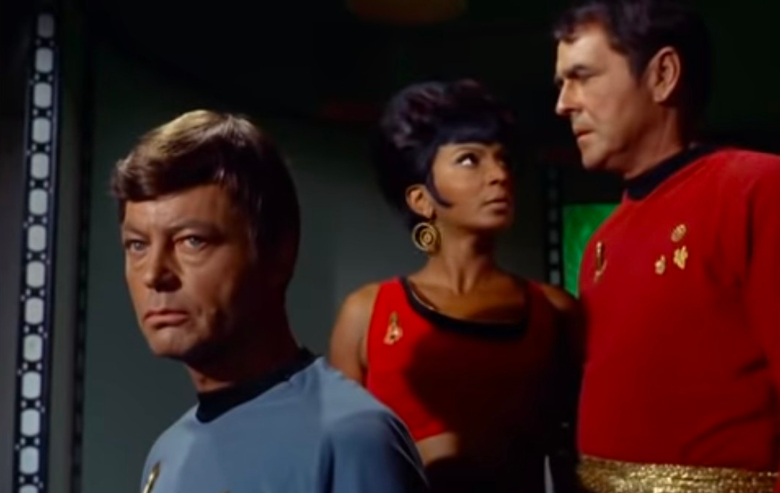
YouTube "Star Trek: The Original Series" episode "Mirror Mirror"
The Mirror Universe was first introduced in the “ Star Trek: The Original Series ” episode “Mirror Mirror.” In that episode, a transporter accident sent Captain Kirk , Dr. McCoy , Lieutenant Uhura , and Chief Engineer Mr. Scott to an alternate universe. Upon their arrival, the Enterprise crew members discovered that they were on an alternate version of the Enterprise filled with alternate versions of the people with whom they served. This led them to dub the alternate universe “the Mirror Universe.”
Kirk, McCoy Uhura, and Scotty also discovered that the political and social climate was much different in this alternate universe. The tyrannical Terran Empire ruled the quadrant with ruthlessness and violence.
Since the Mirror Universe was first introduced, it has played a major role in three other “ Star Trek ” shows. Five episodes of “ Star Trek: Deep Space Nine ” were either set in the Mirror Universe or included characters from the Mirror Universe. Two episodes of “ Star Trek: Enterprise ” were set in the Mirror Universe. Most recently, “ Star Trek: Discovery ” did a multi-episode storyline set in the Mirror Universe, and introduced the first Mirror Universe counterpart to stay in the Prime Universe.
Coming up with a cohesive timeline of the Mirror Universe is tough for many fans because each show depicted a different time period in that universe. TOS showed the Mirror Universe in the 2200s, DS9 depicted the Mirror Universe in the 2300s, “Enterprise” portrayed the Mirror Universe in the mid-2000s and 2100s, and “Discovery” took fans back to the Mirror Universe in the 2200s before Kirk and his crewmates discovered it.
So, it can be hard to keep track of what happened and when in the Mirror Universe, especially for fans watching the shows in the order they aired. So, we’ve created this guide to the biggest events in the Mirror Universe history and which episodes depict them.

The Mirror Universe in the 2000s and 2100s
Prior to First Contact:
The exact date that the Terran Empire rose to power in the Mirror Universe hasn’t been revealed in the “Star Trek” canon. In “Enterprise” two-parter “ In a Mirror, Darkly ,” Commander Jonathan Archer said that the Terran Empire had existed for centuries as of the 2100s. In the “Discovery” episode “ Vaulting Ambition ,” Emperor Phillipa Georgiou hinted that the Terran Empire had been around for millennia.
2063: First Contact
Just as he had in the Prime Universe, Mirror Universe Zefram Cochrane piloted the first successful warp flight in 2063. However, the greeting he gave the Vulcans was much different than his Prime counterpart’s. The episode “In a Mirror, Darkly” showed Mirror Cochrane shooting the Vulcan delegation and ordering his crew to loot their ship.
2063-2155: Terran Empire Rises to Power
“In a Mirror, Darkly” and “ In a Mirror, Darkly Part II ” revealed that the Terran Empire took control of the Alpha Quadrant sometime in the late 2000s or early 2100s. The conflict that ended with the Terran Empire’s supremacy began when the Lunar Colonies were attacked. The Terran Empire used this as an excuse to amp up aggressions against the other Alpha Quadrant species, and it conquered the Vulcans, Andorians, Tellarites, Denobulans, and the Orions.
2155: Mutiny on the ISS Enterprise & the USS Defiant
In the same two-parter, Commander Jonathan Archer led a mutiny against his Captain, Maximillian Forrest . Archer took over the ISS Enterprise so its crew could investigate the spatial interphase that moved the USS Defiant through time and space into the Mirror Universe from the Prime Universe.
When Forrest regained control of the ship, Archer tried to use the Defiant to defeat the Enterprise. Unfortunately, he was then the subject of another mutiny led by Mirror Hoshi Sato , who declared herself Empress of the Terran Empire.
The Mirror Universe in the 2200s
The Early 2250s: The Coup Against Georgiou
In the episode “Vaulting Ambition,” Emperor Georgiou revealed that Captain Gabriel Lorca led a coup against her. She also revealed that Mirror Commander Burnham , her adoptive daughter, had joined Lorca’s attempt to overthrow the Empress.
Later in that episode, Lorca revealed that when he tried to transport back to his ship to escape, he ended up in the Prime Universe. He impersonated his Prime Universe counterpart, who was a member of Starfleet. When he heard about the experimental spore drive technology, he finagled his way into the captain’s seat of the USS Discovery, determined to make his way back to the Mirror Universe to finish what he started.
2256: Lorca and the Discovery Enter the Prime Universe
After commanding the Discovery for less than a year, Lorca finally figured out how to jump back into the Mirror Universe. In the episode “ Despite Yourself ,” Lorca convinced Prime Commander Burnham to impersonate her Mirror Universe counterpart and bring him to Emperor Georgiou. He told Burnham that this was the best way for them to get the information they needed to get back to the Prime Universe.
However, in the episode “Vaulting Ambition” his true intentions became clear. He wanted to get back to Georgiou’s ship so he could make contact with his supporters and lead another coup.
Commander Michael Burnham impersonated her Mirror Universe counterpart for three episodes — “Despite Yourself,” “ The Wolf Inside ,” and “Vaulting Ambition” — before telling Georgiou that she was actually from the Prime Universe. In the episode “ What’s Past is Prologue ,” Lorca tried to convince Burnham to join his coup as her Mirror counterpart had. However, she chose to assist the Emperor instead.
After they defeated Lorca, Georgiou grabbed onto Burnham just as she was being transported to the Discovery. So, she ended up on the Discovery when it transported back to the Prime Universe. Starfleet decided to cover up the fact that Georgiou was Mirror Georgiou by having her impersonate her Prime Universe counterpart.
2267: Kirk & Crew Cross Over
The very first episode about the Mirror Universe came years after the Trek canon’s first encounter with the Mirror Universe thanks to prequels like “Enterprise” and “Discovery.”
In “Mirror Mirror,” Kirk and his crew members crossed over to the Mirror Universe and impersonated their Mirror Universe counterparts. Kirk’s unwillingness to carry out the Terran Empire orders to destroy a planet led Mirror Spock to doubt whether Kirk was really his Kirk.
Eventually, Mirror Spock performed a mind-meld on Dr. McCoy and discovered that Kirk, McCoy, Uhura, and Scotty were from the Prime Universe. In a logical but uncharacteristic show of compassion, Spock let them beam back to the Prime Universe. Before they did, Kirk warned Mirror Spock that the Terran Empire would be overthrown if they didn’t find a way to govern without brutality. Spock agreed.
The Late 2200s: Spock’s Reign & Downfall
Sometime after his encounter with Prime Kirk, Mirror Spock rose to the highest seat in the Terran Empire. In the DS9 episode “ Crossover ,” The Intendant aka Mirror Kira Nerys informed her Prime Universe counterpart that Spock instituted sweeping reforms that weakened the Terran Empire’s control over the Alpha and Beta Quadrants.
The Klingons and the Cardassians formed an alliance to overthrow the Terran Empire, which they did relatively easily. The Bajorans joined The Alliance to protect themselves from the rampant threats in the quadrant.
The Mirror Universe in the 2300s
2370: Kira and Julian Bashir Cross Over
In that same DS9 episode, Kira and Chief Medical Officer Julian Bashir crossed over to the Mirror Universe while traveling through the wormhole. They discovered that The Alliance was in power and Terrans were used as slaves throughout the Alpha and Beta Quadrants.
Mirror Kira told Prime Kira that since Kirk had crossed over to the Mirror Universe, safeguards had been put in place to prevent crossovers, and Prime Universe counterparts were supposed to be killed on sight.
In an attempt to escape back to the Prime Universe, Prime Kira and Prime Bashir convinced Mirror Miles O’Brien , aka Smiley, and Mirror Benjamin Sisko to rebel against The Alliance. This kicked off a rebellion that lasted for several years. Kira and Bashir made it back to the Prime Universe and updated the crew of Deep Space Nine.
2371: Smiley Crosses Over and Abducts Sisko
In the episode “ Through the Looking Glass ,” Mirror O’Brien, Smiley, modified a transporter so he could cross over to the Prime Universe. He then downloaded key information from the Deep Space Nine computer, abducted Prime Sisko, and took him back to the Mirror Universe.
Once there, Smiley revealed that Mirror Sisko had died in a battle with The Alliance. However, Smiley didn’t want anyone to know about Mirror Sisko’s death. He was the leader of the Terran Rebellion and pretty much the only person keeping the effort together. Plus, he was supposed to convince his ex-wife, Mirror Jennifer Sisko, to betray the Alliance and join the rebellion.
Sisko agreed because he didn’t want the Mirror version of his wife to be killed by the Terran Rebellion. He manages to convince her to switch sides and gets back to the Prime Universe with the help of the rebels.
2372: The Seizure of Terek Nor
Just a year later, the Terran Rebellion was so powerful that they were able to take over Terek Nor, the ore processing station that served as a major base of operations for The Alliance. The episode “ Shattered Mirror ” revealed that the rebellion also managed to build a version of the USS Defiant based on plans Smiley had stolen from the Prime Universe. However, they couldn’t get the ship to function properly.
So, Mirror Jennifer crossed over to the Prime Universe to convince Prime Sisko to help them. She did so by kidnapping his son, Jake , and taking him back to the Mirror Universe. When Sisko followed and saw how desperate the rebels were to fight The Alliance, he agreed to help. He ended up piloting the ISS Defiant into a battle against The Alliance, winning the day for the rebels.
2374: The Attempted Reunification of Mirror Bajor
In the episode DS9 episode “ Resurrection ,” Intendant Kira sent a thief to the Prime Universe to steal one of the Bajoran Orbs . She believed that if she possessed an Orb, she could unify Bajor and become its rightful leader. Eventually, she also crossed over to the Prime Universe to see the plan through.
They were thwarted by Prime Kira and Prime Odo, who let them cross back over to the Mirror Universe.
2375: The Ferengi Incident
A year later, Prime Grand Nagus Zek used a multidimensional transporter to cross over to the Mirror Universe to establish business dealings in the Mirror Universe, as shown in the episode “ The Emperor’s New Cloak .” However, upon his arrival, he was captured by The Alliance. They sent a mercenary, Mirror Ezri Dax , to inform Quark and Rom of the kidnapping and demand ransom.
When Quark and Rom transported over the Mirror Universe with Ezri, they were all captured by the Terran rebels. Quark and Rom tried to fulfill the ransom demanded by The Alliance while they were in Terran custody, but as it often does with Ferengi, only chaos ensued.
In a major turn of events, Ezri betrayed The Alliance and joined the rebels. The Terran Rebellion made another stand against The Alliance and the episode ended with the hint that they were victorious. However, the Trek canon is not clear on what happened in the Mirror Universe after 2375.
Star Trek Online Canon
The PC and console video game Star Trek Online (STO) continued the story of the Mirror Universe. Though STO is not “Star Trek” canon, it expanded the Mirror Universe in ways that fans have loved.
In the Star Trek Online canon , the Terran Rebellion defeated The Alliance in the early 2400s. This led to the new Terran Empire, which went back to its previous totalitarian ways. The STO canon introduced a war between the Mirror and Prime Universes, of which Admiral Leeta , the Mirror version of DS9’s Leeta, is a major player.
Follow the Heavy on Star Trek Facebook page for the latest breaking news, rumors and content!
Now Take the Quiz
More heavy on star trek news.
Star Trek's Mirror Universe Explained
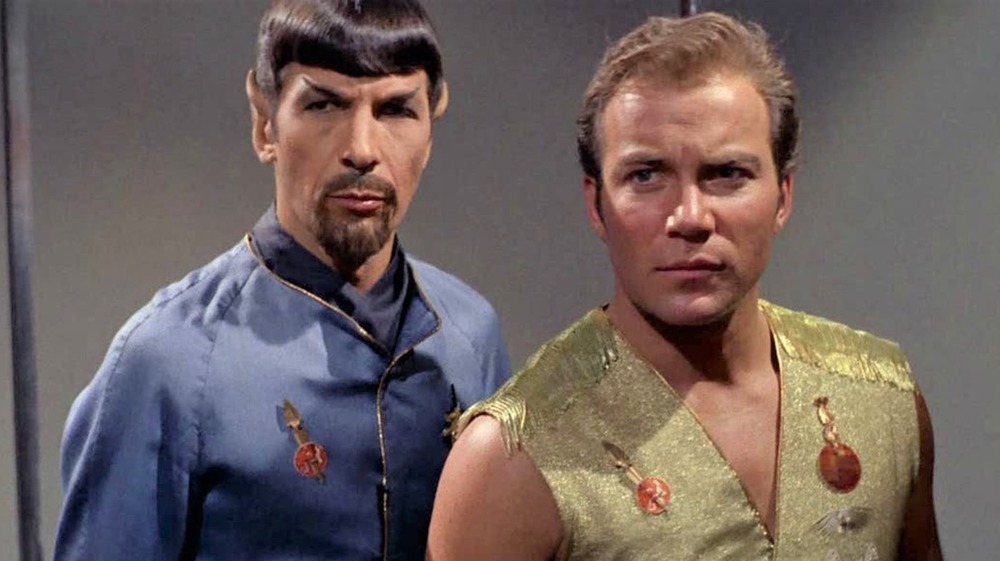
In the iconic narration of Star Trek: The Original Series ( TOS ), Captain James T. Kirk vows to go "where no man has gone before." Numerous television series and films later, not only does Kirk make good on his promise, but he's joined in his quest to map the unknown by other heroic captains and crews. Whether by accident or on purpose, Star Trek 's heroes have found themselves lost in distant corners of the galaxy, tossed on the eddies of time, caught in the crossfire of wars waged on other planes of existence, and once — no, really — in Sherwood Forest.
One of the stranger locations that Star Trek keeps bringing its heroes back to is known as the Mirror Universe. The brutal locale makes its first appearance in "Mirror, Mirror" — a season 2 episode of TOS airing in 1967. It would take 27 years for Trek heroes to make their way back to the place in Star Trek: Deep Space Nine 's ( DS9 ) season 2 episode "Crossover." Since then, the gates to the Mirror Universe have stayed busy. Along with subsequent episodes of DS9 , the Mirror Universe and its twisted characters have returned in the prequel series Star Trek: Enterprise ( ENT ) and Star Trek: Discovery , and creators of non-canonical Trek media have taken the opportunity to bring the crews of other series to this weird world.
But what is the Mirror Universe? To find out, keep reading for Star Trek 's Mirror Universe explained.
WARNING! Spoilers for multiple Star Trek series follow!
What is the Mirror Universe?
What if everything was different? What if cowards were heroes, heroes were villains, and villains ruled over everything? Star Trek answers this question with its parallel reality, the Mirror Universe.
These days it's tough to have any kind of interest in science fiction and not be familiar with the concept of parallel universes, but Star Trek 's Mirror Universe isn't just different. As the name implies, the people of the Mirror Universe are often the exact opposite of their Prime Universe counterparts. The United Federation of Planets and its hallowed ideals are replaced by the Terran Empire and a barbaric "might makes right" philosophy. In Starfleet's place is the Imperial Starfleet, and its captains — known for their compassion and tolerance in the Prime Universe — are ruthless, unforgiving, and often xenophobic. The quickest way to get ahead in the Imperial Starfleet is to assassinate your superior officer, and the only consistent forms of discipline are torture — usually in the form of the excruciating agonizer booths — and death.
While the Mirror Universe characters are the opposite of the Prime Universe counterparts, that doesn't always change their roles in terms of being heroes or villains. The Mirror Universe version of DS9 's Miles O'Brien , for example, is largely depicted as being heroic, though the Mirror O'Brien is willing to do things — like kidnapping — in order to achieve his goals that the prime O'Brien probably wouldn't stoop to.
The first crossing
In 1996's Star Trek: First Contact , Zefram Cochrane lays the groundwork for the founding of the Federation when he greets the first Vulcan to visit Earth. But in the two-part ENT episode "In a Mirror, Darkly," the Mirror Cochrane instead murders the Vulcan, paving the way for the oppression and brutality of the Terran Empire.
Fast forward a hundred years later to the Terran Empire's version of the Enterprise , where Jonathan Archer is only a first officer. Mirror Archer is much more ruthless than his Prime counterpart, and he stages a coup to take over command of the ship. Among other things, we learn the Mirror versions of Dr. Phlox and Malcolm Reed are the inventors of the excruciating agonizer booths and that T'Pol is working with the Vulcans and other oppressed Imperial races in their rebellion.
Unlike most Mirror Universe episodes, none of the main characters from the Prime Universe cross over ... except in Archer's mind. After learning of the other universe, Mirror Archer has maddening visions of the Prime Archer taunting him. The story cleverly crosses over with the TOS episode "The Tholian Web," transplanting the captured USS Defiant not only from the Prime Universe but through time. Archer and his crew capture the Defiant and use its superior technology to cripple the rebellion and to put Archer in the position to take the Imperial throne. In the final moments of the episode, however, Hoshi Sato — who Archer believes to be his loyal concubine — poisons him, taking the throne for herself.
A Mirror Universe stowaway
For most of Discovery 's first season, the eponymous vessel is commanded by Captain Gabriel Lorca, a man whose sensitivity to light — we're told — is a result of his injuries aboard the USS Buran . By the end of the first season, however, we learn Lorca is perhaps the most deceitful captain in the history of Trek 's commanding officers . Lorca is, in fact, a native of the Mirror Universe masquerading as his Prime counterpart. His identity as a Terran accounts for his light sensitivity, though this is the first time we learn of this aspect of Terran biology.
We never learn exactly when the Mirror Lorca crossed over to the Prime Universe, nor do we know the fate of the Prime Lorca. It's speculated he couldn't have survived alone in the Mirror Universe, but we never find out for sure. All we know is that as soon as he learned of Discovery 's unique spore drive, Mirror Lorca did everything he could to find himself in the experimental ship's command chair in order to use the drive to bring himself back to the Mirror Universe and continue his rebellion against Emperor Philippa Georgiou.
At the end of "Into the Forest I Go," Lorca finally puts his plan into action. When the rest of the crew believes they're using the drive to jump to Starbase 46, Lorca secretly diverts the ship to the Mirror Universe. He reignites his rebellion against the Emperor, only to be killed by Georgiou in "What's Past is Prologue."
The Emperor's new clothes
In the Prime Universe, Philippa Georgiou was the captain of the USS Shenzhou — Michael Burnham's commanding officer who died during the Battle of the Binary Stars. But in the Mirror Universe, Georgiou is the emperor of the Terran Empire. While the Mirror Georgiou seems content to die fighting Lorca's followers, Burnham saves her against her wishes, bringing her back to Discovery and subsequently to the Prime Universe.
With unmatched combat skills and a devious mind, Mirror Georgiou becomes a great asset to the clandestine operations of Section 31. The official word from Starfleet is that the prime Georgiou somehow miraculously survived the Battle of the Binary Stars. It's agreed that the existence of the Mirror Universe is to be purged from all records because of the concern that in the wake of the devastating war with the Klingons , Federation citizens who learn of the Mirror Universe might attempt to cross over to find counterparts of their dead loved ones.
While Georgiou resists any attempts by her new Prime allies to make her any less savage, it's clear she holds a special place in her heart for Burnham whose Mirror counterpart is her adopted daughter. Georgiou eventually rejoins the crew of the Discovery and becomes an integral part of their efforts against the rogue A.I. Control. She's also among the heroes when they choose to purposely strand themselves in the distant 32nd century.
Kirk visits the Mirror Universe
In the opening of "Mirror, Mirror," Captain Kirk, Scotty, Uhura, and Bones are on surface of the Halkan homeworld, having tried and failed to negotiate dilithium mining rights. But somehow, due to a raging ion storm, when the four Federation officers are beamed back to Enterprise , they find themselves aboard the version of the ship in the Mirror Universe instead of their own. Meanwhile, their Mirror counterparts are sent to the Prime Universe where they're soon imprisoned. "Mirror, Mirror" takes place approximately a decade after Discovery 's crossover, but because of Starfleet's decision to keep the place a secret, Kirk and his crew don't know what they're in for.
On board the Mirror Enterprise , everyone's in strange uniforms, including female crew members being in much more revealing outfits (and it isn't like the Prime Uniforms were particularly conservative). Most conspicuously, everyone gives each other salutes reminiscent of the infamous Nazi one-arm salute.
Kirk and his colleagues from the Prime Universe struggle to remain incognito while they search for a way back home. See, rather than negotiating, the Terrans are threatening the Halkans with annihilation if they don't allow them to mine dilithium. And Kirk raises suspicions when he refuses to fire on the planet, inspiring an assassination attempt. The bearded Mirror Spock eventually discovers the identity of the Prime Universe heroes and allows them to return, wanting his own captain back. However, Spock's time with the Prime Kirk proves more consequential than anyone at the time imagines.
The fall of the Terran Empire
In season 2 of DS9 , heroes from Trek 's Prime Universe find themselves in the Mirror Universe for the first time in over a century. In "Crossover," Major Kira and Dr. Bashir come across a very different Deep Space Nine. In the Mirror Universe, DS9 is still named Terok Nor, but Odo is a slavedriver, Sisko is a pirate, and the Ferengi bartender Quark doesn't even know what latinum is.
Rather than Starfleet, Terok Nor is ruled by the Klingon-Cardassian Alliance (KCA). Bajor is a part of the KCA, and the world's ruler — who also presides over the station — is the cold-blooded and seductive Intendant Kira, one of Star Trek 's best villains . From the Intendant, Prime Kira learns that Kirk's trip to the Mirror Universe in TOS had far-reaching consequences. Kirk so inspired Mirror Spock that the Vulcan helped bring about a series of compassionate reforms throughout the Terran Empire. Sadly, their lapsed focus on defense made them easier targets for the KCA. The Terrans are now a conquered people, working as slaves for the KCA and forced to wear clothing bearing the symbol of Earth to identify themselves. Because of this, while Intendant Kira treats her Prime counterpart as a treasured pet, Bashir is pressed into slavery as soon as he arrives.
Kira and Bashir eventually escape with the help of the Mirror versions of Miles O'Brien — better known as "Smiley" in the Mirror Universe — and Sisko. Like Kirk before them, Bashir and Kira inspire change in the darker universe.
The Terran Rebellion
DS9 's lead, Captain Sisko, is kidnapped and brought to the Mirror Universe by Smiley in season 3's "Through the Looking Glass". He learns that when his Mirror counterpart betrayed the KCA in "Crossover," the act started a Terran rebellion. Now, Smiley needs Sisko to help the rebellion by pretending to be his Mirror counterpart long enough for one last mission.
DS9 tracks the conflict between the Terrans and the KCA intermittently throughout the series, offering one Mirror episode every season except for its first and fifth. While the group refers to itself as the Terran Rebellion, other oppressed races are part of the struggle. Star Trek: Voyager 's Tuvok — a Vulcan — makes a cameo as part of the rebellion in "Through the Looking Glass." Plus, other races are spotted in their gatherings. Like the Maquis of the Prime Universe, they hide in the Badlands, where the KCA's sensors can't find them. Their leaders include much tougher and no-nonsense versions of Bashir and Jadzia Dax.
Things are looking up for the Terrans by the final DS9 Mirror episode, "The Emperor's New Cloak." By the end of the episode, the Terrans have their own version of the Defiant , complete with a game-changing cloaking device, and they've captured Terok Nor. At the same time, the KCA leadership is in disarray. Intendant Kira is on the run, Garak is dead, and the KCA regent — a much more sadistic and violent version of Worf — is the Terrans' prisoner.
The Mirror Universe rebooted?
Discovery 's season 3 two-parter "Terra Firma" reveals the crew's Mirror Universe native Philippa Georgiou is dying because of their journey to the 32nd century. Because 900 years have passed since Georgiou's crossing to the Prime Universe, the Prime and Mirror Universes are no longer aligned, causing her molecular cohesion to deteriorate.
Learning of a world with a possible cure, Discovery brings Georgiou to a planet where a mysterious man keeps vigil over what appears to be a door leading to nowhere. In the second part of "Terra Firma," we learn this is the Guardian of Forever, who first appears in the classic TOS episode "The City on the Edge of Forever," one of Star Trek 's saddest tales . The Guardian allows Georgiou to rejoin her life as emperor of the Terran Empire, where she tries and fails to redeem the Mirror Michael Burnham and save her life. Her attempts at peace and her compassion toward the Mirror Saru, however, convince the Guardian she's worth saving. The Guardian then sends her back to the 23rd century.
The Guardian makes it clear Georgiou's trip back in time — which ends in her death — was no illusion. Since her Mirror Universe adventure all takes place before the Mirror episodes of Discovery 's first season, does that mean most of the history of the Mirror Universe has been altered? Or did her actions create another parallel timeline — a second Mirror Universe?
Time travel — it's confusing and causes problems.
The untold story of Tiberius
In TOS ' "Mirror, Mirror," Prime Kirk discovers his Mirror counterpart has been secretly using a device called the Tantalus Field. With it, Mirror Kirk can monitor anyone on his ship and, should he choose, disintegrate them with the touch of a button. His concubine, Marlena, says it's how he became captain, implying he used it to murder his predecessor. But according to the "Before Her Time" documentary on the season 4 Enterprise Blu-ray, there was almost a reveal that the device did something else entirely.
According to the documentary, rather than the two-parter which ultimately became "In a Mirror, Darkly," the Enterprise creators wanted William Shatner to reprise his role as the Mirror Kirk, aka Tiberius. In "Mirror, Mirror," it's said Tiberius got the Tantalus Field from an alien scientist's "plundered lab." The proposed Enterprise story would reveal that rather than killing, the device actually sends its victims to a penal colony in the Prime Universe. Tiberius would find himself at this prison, presumably surrounded by a bunch of people he sent there, such as his predecessor, who would likely have been the Mirror Captain Pike.
Unfortunately, negotiations between Shatner and Paramount didn't work out. However, it's fun to consider the idea of Shatner reprising the role, particularly when you consider how little we see of Tiberius in "Mirror, Mirror."
Picard's Enterprise in the Mirror Universe
Unfortunately, Star Trek: The Next Generation doesn't include any trips to the Mirror Universe. Plus, the history of the Mirror Universe as it's presented in DS9 would seem to discount any Mirror versions of either the TNG or Voyager crews since the Terran Empire would've been conquered long before those groups existed. But while it's not considered part of official Trek canon, some clever comic book creators found a way to tell the story of the Mirror TNG heroes.
In 2017, IDW released the miniseries Star Trek: The Next Generation — Mirror Broken , written by Scott and David Tipton and with art by J.K. Woodward. We learn that the news of the Terran Empire's demise is the result of exaggeration and rumor. The Klingon-Cardassian Alliance has bitten huge chunks out of the Empire, but it's far from dead. Mirror Broken begins with the Mirror Jean-Luc Picard as captain of the Stargazer , while most of the series follows his efforts to take over the Enterprise . The motley cast includes a bearded Picard, a spiky-haired Wesley Crusher, and a surprisingly confident and competent Lieutenant Barclay.
Broken Mirror isn't the last we see of the ISS Enterprise , either. In 2018, the same creative team released two follow-up miniseries – Through the Mirror and Terra Incognita — that depict the pirates making their way to the Prime Universe.
The Pirate Queen of the Delta Quadrant
The TNG crew aren't the only ones to get the Mirror Universe treatment in the comics. In 2019, IDW released Star Trek: Voyager — Mirrors and Smoke by Paul Allor and J.K. Woodward. A quick prologue explains that Captain Janeway and her crew were part of the Terran Rebellion against the Klingon-Cardassian Alliance before being flung to the Delta Quadrant. Unlike their Prime Universe counterparts, they're quite happy being far from the KCA and decide to stay where they are.
Voyager 's bloody reputation has earned Janeway the title Pirate Queen of the Delta Quadrant. Mirror Neelix and Kes — Delta Quadrant natives who join the crew in the series — are Janeway's rivals. The ship's command structure is a bit different, as well. In the series, Commander Cavit is replaced by Chakotay as first officer after Cavit is killed, whereas in Mirrors and Smoke , it's Chakotay who murders Cavit in order to climb the command ladder.
One of the most interesting transformations we see is that of Annika Hansen, aka Seven of Nine in the Prime Universe. Hansen was never assimilated by the Borg in the Mirror Universe, though ironically, she still plots — alongside the Doctor, who's disgruntled from his poor treatment by the Terrans — to take over the ship.
Den of Geek
Star Trek: A Guide to All the Mirror Universe Episodes
What can we learn about Star Trek: Discovery from these previous Mirror Universe-set Star Trek episodes?

- Share on Facebook (opens in a new tab)
- Share on Twitter (opens in a new tab)
- Share on Linkedin (opens in a new tab)
- Share on email (opens in a new tab)
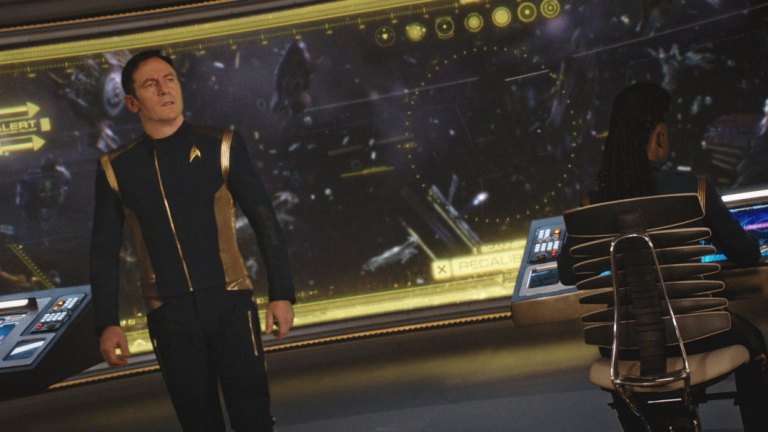
Warning: This article contains Star Trek: Discovery spoilers.
In this week’s episode of Star Trek: Discovery , we got confirmation that the crew of the Discovery has landed in the franchise’s Mirror Universe where, instead of the peace-loving Federation, Earth has its own, tyrannical Terran Empire.
The Star Trek franchise has a history of episodes and arcs that take place in this Mirror Universe. They are often amongst the strongest storytelling of their respective series and build upon the Mirror Universe mythology that has come before.
As we head further into Discovery ‘s incarnation of the Mirror Universe, let’s look back at all of the Mirror Universe episodes in Star Trek ‘s history…
Ad – content continues below
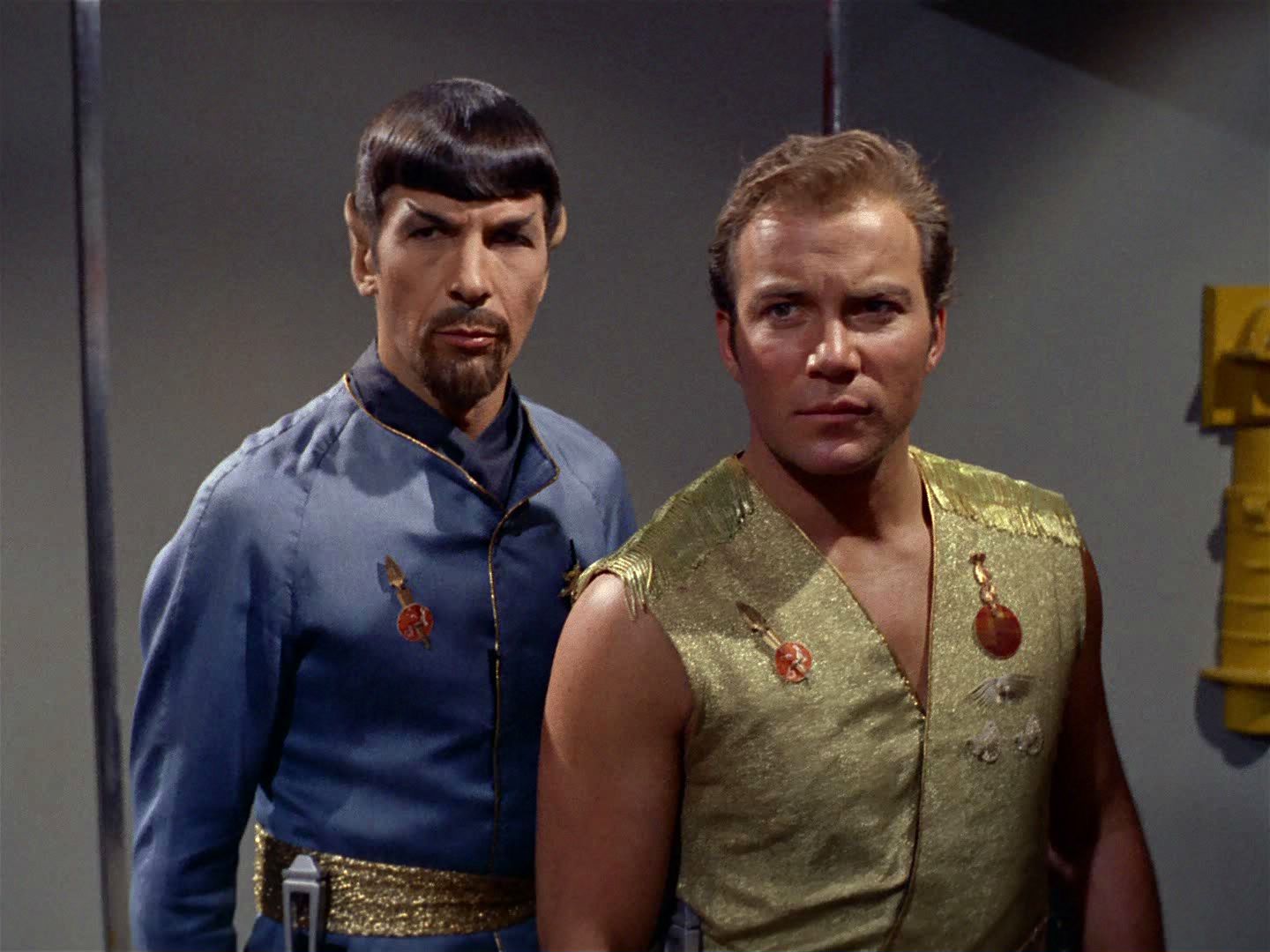
The Original Series’ Mirror Universe
The one that started it all! The Original Series first ventured into the Mirror Universe in Season 2’s “Mirror, Mirror,” when four members of the Enterprise’s crew are switched with their nefarious counterparts in the Mirror Universe.
Discovery has drawn many of its Mirror Universe elements from this original incarnation, including the Agony Booths and the Terran Empire’s preferred method of job promotion: betrayal and murder.
Discovery also borrows “Mirror, Mirror”‘s logic that one does not simply travel to the Mirror Universe, but must switch places. The Mirror Universe’s Discovery has seemingly ended up in our Discovery’s universe, which will no doubt cause all manner of problems for the Federation.
There better be at least one goatee in Discovery ‘s mirror universe or I’m asking for a refund. (Though Tilly’s Terran ‘do is a good start.)
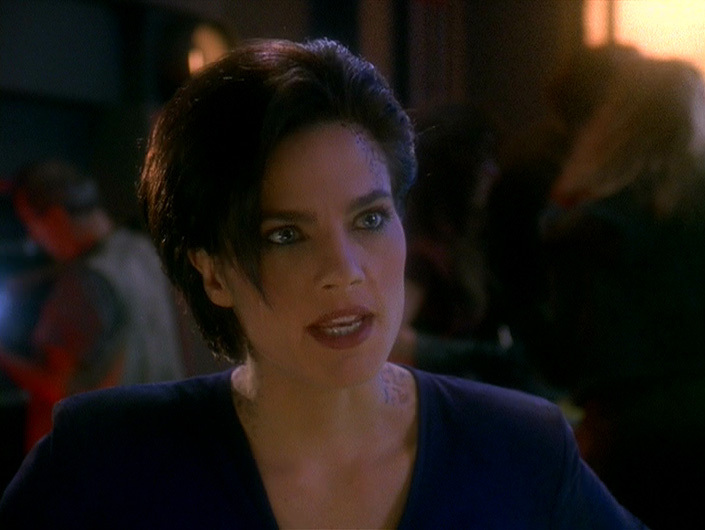
Deep Space Nine’s Mirror Universe
Deep Space Nine did a deep dive into the Mirror Universe with five separate episodes across five different seasons: “Crossover” (Season 2), “Through the Looking Glass” (Season 3), “Shattered Mirror” (Season 4), “Resurrection” (Season 6), and “The Emperor’s New Cloak” (Season 7).
While the Deep Space Nine Mirror Universe story arc doesn’t seem to have much to do with Discovery ‘s take so far, its thematic foundation of the narrative rested on the idea that those who visited the Mirror Universe had a positive effect on the Terran Empire, which began to reform itself for the better. Could the Discovery’s visit to the Mirror Universe have been part of that path to change?
DS9 ‘s visit to the Mirror Universe also introduced the idea that people who died in the “normal” universe might be alive and well in the Mirror Universe, as we found with Sisko’s wife. In “Despite Yourself,” we met Mirror Connor, another version of the Shenzhou’s ensign. It seems inevitable that we will meet more mirror versions of characters who’ve died in our universe. My favorite theory? That Phillipa Georgiou is the Emperor of the Terran Empire.
Get the best of Den of Geek delivered right to your inbox!
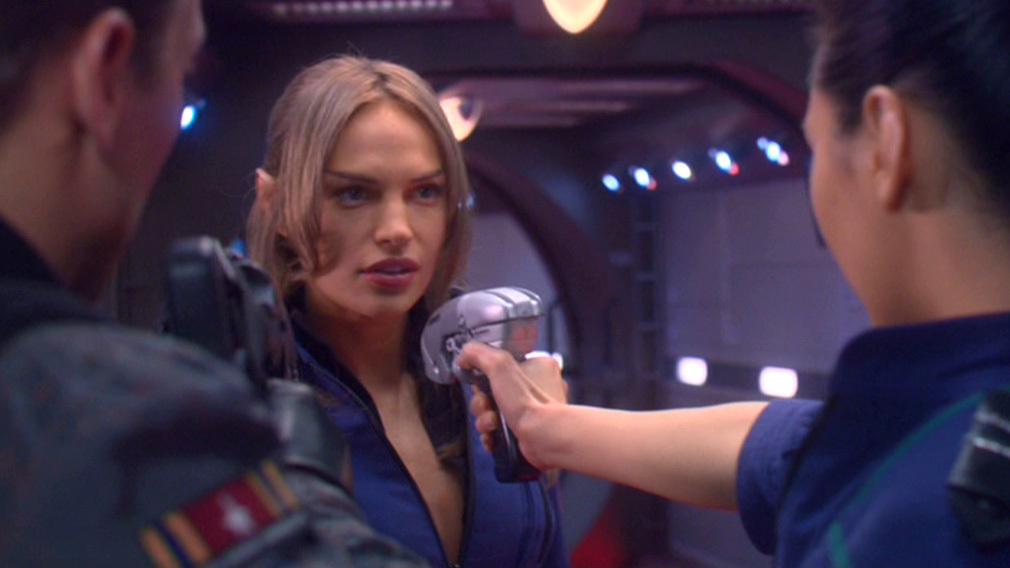
Enterprise’s Mirror Universe
Enterprise really hit its narrative stride when it ventured into the Mirror Universe in “In a Mirror, Darkly, Parts 1 & 2,” which saw the show imagining a fate for the USS Defiant, the missing ship the Enterprise is looking for in The Original Series episode “The Tholian Web.”
What happened to the Defiant, per Enterprise canon? Basically, the crew went crazy, turned on each other, and ended up in the hands of the Tholians. The crew of the ISS Enterprise, captained by a Mirror Universe version of Jonathan Archer, steal the ship from the aliens and attempts to use it to overthrow the Empire. The Defiant has already had a mention in Discovery as a ship that has previously crossed over to the Mirror Universe.
These episodes give us the backstory for the Terran Empire, and how it ended up so different from our universe’s Federation. It imagines the famous first contact between human Zefram Cochrane and the Vulcans going very differently. Instead of a peaceful interaction, Cochrane kills the lead Vulcan and he and other humans loot the ship. Yeah, the Mirror Universe is the worst.

Kayti Burt | @kaytiburt
Kayti is a pop culture writer, editor, and full-time nerd who comes from a working class background. A member of the Television Critics Association, she specializes…

The Alternative Factor (episode)
- View history
- 1.2 Act One
- 1.3 Act Two
- 1.4 Act Three
- 1.5 Act Four
- 2 Log entries
- 3 Memorable quotes
- 4.1 Production timeline
- 4.3 Cast and characters
- 4.4 Sets and props
- 4.5 Costumes and make-up
- 4.6 Effects
- 4.7 Continuity
- 4.8 Reception
- 4.9 Remastered information
- 4.10 Video and DVD releases
- 4.11 Apocrypha
- 5.1 Starring
- 5.2 Also starring
- 5.3 Guest star
- 5.4 Featuring
- 5.6 Uncredited co-stars
- 5.7 Stunt doubles
- 5.8.1 Unreferenced materials
- 5.9 External links
Summary [ ]
In standard orbit around an iron - silica -type uncharted planet , the USS Enterprise prepares to complete its survey, when the starship is violently rocked twice and everything within sensor range suddenly "blinks", almost as if the universe is on the verge of ceasing to exist. And, in the wake of this, a man appears on the surface of the planet, where moments earlier there was no life.
Act One [ ]
Beaming down, Captain Kirk , Spock , and the landing party encounter a man. " You came! Thank the heavens , it's not too late! ", he exclaims. Dirty and disheveled, he falls from a rock. The landing party returns to the Enterprise with him, where Kirk learns more news – the strange phenomenon drained the dilithium crystals almost completely. Still worse, Starfleet Command issues a Code Factor 1 message – invasion status. The effect experienced by the Enterprise was also experienced everywhere in the galaxy , and far beyond. Starfleet withdraws all nearby ships – Commodore Barstow informs Kirk that the Enterprise is the bait.
In his quarters , Kirk talks to his "guest" – a man named Lazarus , who is pursuing a "thing," a monster who destroyed his entire civilization. He informs Kirk that he will stop at nothing to destroy it. Beaming back down to the planet, Kirk learns from Spock that there is no other creature here. Spock, accusing Lazarus of lying, states " I fail to comprehend your indignation, sir. I have simply made the logical deduction that you are a liar. " Kirk demands the truth – and the universe turns inside out once again. The same "winking" phenomenon occurs again. And Lazarus – first he has a bandaged forehead, and then he doesn't, and then he does again.
Act Two [ ]
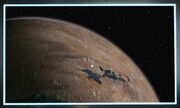
Strange energy visible on the planet on the viewscreen
Meanwhile, Spock has discovered a source of radiation that is not there – a "rip" in the universe, where regular physical laws do not apply. The key to locating this source seems to be the dilithium crystals – a revelation which excites Lazarus, who demands the impossible: that Kirk give him the crystals.
The captain refuses, but Lazarus overpowers Lieutenant Charlene Masters as well as an engineering officer and steals two dilithium crystals, nevertheless.
Act Three [ ]
In the briefing room , Kirk confronts Lazarus, but he denies it, blaming his monster. And the evidence suggests he isn't the thief, for the crystals are not aboard his ship. In Sick Bay, Kirk confronts Lazarus with his lies, which Lazarus explains away by claiming that he is a time traveler ; his spaceship is actually a "dimensional corridor gateway"and The dead world the Enterprise orbits is the distant future of his destroyed homeworld; the place and time he has traveled to in pursuit of the monster. At Dr. McCoy 's urging, the crew departs Sick Bay to allow Lazarus to rest and recover from his fall. [[ Having relocated to the briefing room to consider all of the known evidence, Kirk and Spock conclude that the strange energy must come from a source outside the universe. A source in another, parallel universe. There are two copies of Lazarus, and they are periodically exchanging places through a kind of door – and if they ever exist in the same universe at the same time, everything, everywhere, will be annihilated in a cataclysmic matter / antimatter explosion.
Meanwhile, the alternative Lazarus creates a diversion by starting a fire in main engineering, steals the ship's energy crystals, then beams down. Kirk pursues. As he attempts to enter Lazarus' spaceship, he vanishes, hurled through the corridor into the other universe.
Act Four [ ]
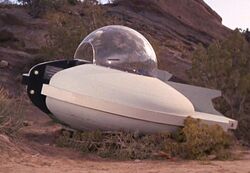
Lazarus-A timeship; Lazarus-B timeship was identical except that the dome on top had been taken off
Once there, Kirk meets the other but sane Lazarus-B, and learns the truth. Lazarus-B's people discovered how to pass through the negative magnetic corridor that both connects and protects the two universes. When this happened, Lazarus-A couldn't bear the knowledge that he had a duplicate, and resolved to destroy his opposite. He is mad and doesn't care if this causes the destruction of two universes. Lazarus-B and Kirk realize he must be stopped: if Kirk can force Lazarus-A into the corridor, Lazarus-B can hold him there, and Kirk can destroy his spaceship – which will also destroy Lazarus-B's spaceship. Access to the corridor will be sealed forever and both universes will be safe, but the men named Lazarus will be at each others' throats for the remainder of eternity. Kirk goes back through the corridor and fights in hand-to-hand combat forcibly throwing Lazarus-A into the "dimensional door." Kirk then has the crystals removed from the timeship and heads back to the Enterprise , ordering Lieutenant Leslie to bring the ship's phasers to target the inter-dimensional ship. The two Lazaruses meet once more and fight as phaser beams vaporize the ship, sealing the two for all of eternity, caught together, between universes. Kirk ruminates on the fact that the two Lazarus are going to be at each other's throats for all time and wonders how it would be. Spock reminds Kirk that the universe[s] are now safe. " For you and me. But, what of Lazarus? What of Lazarus? "
Log entries [ ]
- Captain's log, USS Enterprise (NCC-1701), 2267
Memorable quotes [ ]
" I want facts, not poetry. "
" He's death! Anti-life! He lives to destroy! "
" I told you, it was the thing! All white, black and empty. A terrible emptiness. " " Let's get back to the ship. " " He'll kill us all if we don't kill him first! Kill! Kill! Kill!! Kill!! Kill!!! "
" Are you deaf as well as blind?! "
" I fail to comprehend your indignation, sir. I've simply made the logical deduction that you are a liar. "
" Sometimes pain can drive a man harder than pleasure. "
" Jim, madness has no purpose or reason. But it may have a goal. "
" If they meet. " " Annihilation, Jim. Total, complete, absolute annihilation. "
" So you're the terrible thing? The murdering monster? The creature? " " Yes, captain. Or he is. It depends on your point of view, doesn't it? "
" You'll be trapped inside that corridor with him forever. At each other's throats throughout time. " " Is it such a large price to pay for the safety of two universes? "
" Captain, the universe is safe. " " For you and me. But what of Lazarus? What of Lazarus? "
Background information [ ]
Production timeline [ ].
- Story outline by Don Ingalls : 29 August 1966
- Revised story outline: 12 September 1966
- Second revised story outline: 14 September 1966
- First draft teleplay by Ingalls: 14 October 1966
- Second draft teleplay: 7 November 1966
- Final draft teleplay by Gene L. Coon or Steven W. Carabatsos : 11 November 1966
- Revised final draft teleplay by Coon: 14 November 1966
- Additional revisions: 15 November 1966 , 16 November 1966 , 18 November 1966
- Day 1 – 16 November 1966 , Wednesday – Desilu Stage 9 : Int. Bridge
- Day 2 – 17 November 1966 , Thursday – Desilu Stage 9 : Int. Bridge , Sickbay , Transporter room
- Day 3 – 18 November 1966 , Friday – Desilu Stage 9 : Int. Bridge , Corridors
- Day 4 – 21 November 1966 , Monday – Desilu Stage 9 : Int. Dilithium recharging section , Recreation room (redress of Briefing room ), Sickbay
- Day 5 – 22 November 1966 , Tuesday – Vasquez Rocks Natural Area Park : Ext. Planet surface
- Day 6 – 23 November 1966 , Wednesday – Vasquez Rocks Natural Area Park : Ext. Planet surface
- Day 7 – 25 November 1966 , Friday – Desilu Stage 10 : Ext. Planet surface , "Transdimensional limbo"
- Original broadcast date: 30 March 1967 , postponed from 2 February 1967
- First UK airdate (on BBC1 ): 8 December 1971
- First UK airdate (on ITV ): 7 March 1982
- Remastered airdate: 1 December 2007
- The original script called for a romantic entanglement between Charlene Masters and Lazarus that was eventually cut due to Roddenberry considering it too similar to the romance between Khan and McGivers in " Space Seed ". As stated by Roddenberry in a Season One memo: " In both 'Space Seed' and this story, we have a crew woman madly in love with a brawny guest star and flipping our whole gang into a real mess because she is in love… do they have to do [this] in two of our scripts? " [1]
- There is no officer played by Larry Riddle as noted among the cast for this episode in the Star Trek Concordance (1st Titan edition, p. 28). Lieutenant Larry Riddle was Charlene Masters' jealous boyfriend in the first draft of the script. [2]
Cast and characters [ ]
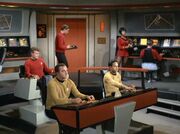
The navigator and Leslie
- James Doohan ( Scott ) and George Takei ( Sulu ) do not appear in this episode. The absence of Scotty has been remarked in several commentaries as being highly unusual, given the extensive exposure in the episode of engineering matters, such as the theft of Dilithium crystals, as well as Lazarus sneaking about engineering and attacking various engineering crew members. (Cushman, Marc, "These are the Voyages", Jacob Brown Press, 2013)
- Curiously, in spite of a higher ranking officer serving as the navigator, this was the second episode that Leslie was seen in the command chair, and the first episode in which Eddie Paskey is credited in the ending credits, albeit misspelled as "Lesley".
- Richard Derr , who plays Commodore Barstow in this episode, later played Admiral Fitzgerald in the episode " The Mark of Gideon ".
- Actor John Drew Barrymore (father of actress Drew Barrymore ) was originally contracted to play Lazarus. Barrymore was scheduled to begin filming on the second day of production, 17 November 1966 , however, the previous afternoon he sent word to the studio that he will refuse to show up to work. Barrymore's replacement, Robert Brown , on the recommendation of his friend, William Shatner , was contacted the same night, literally dragged to the studio and offered the job on the spot, starting the next morning. He recounted the filming to be very tight and tense. ( These Are the Voyages: TOS Season One 1st ed., pp. 415-416)
- The Star Trek production team filed a grievance against Barrymore at the Screen Actors' Guild, which led to him being unable to obtain acting work for six months in 1967. ( Inside Star Trek: The Real Story , pp. 201-202; These Are the Voyages: TOS Season One 1st ed., pp. 415-416, 420)
Sets and props [ ]
- Along with " Friday's Child ", this is one of the only two episodes where outdoor planet scenes were filmed both on Desilu Stage 10 and on location (both times at Vasquez Rocks Natural Area Park ). Originally, all planet-side scenes were scheduled to be filmed on location, but due to the turmoil during production, director Gerd Oswald couldn't finish shooting at Vasquez. Matt Jefferies and the art department prepared a spot on Stage 10 which could accommodate the missing "alternate universe" sequence. ( These Are the Voyages: TOS Season One , 1st ed., p. 418)
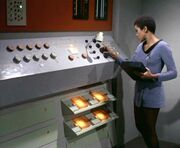
New "recharging section" of Engineering
- This episode introduces a new set, a small subsection of engineering, described in the final draft of the script, dated 11 November 1966 , as the "Lithium [sic] Crystal Recharging Section", which was described as " A portion of Engineering where there are bins into which dilithium crystals are placed for recharging. " Part of the dilithium energizer panel in the set used the same controls as the neural neutralizer from " Dagger of the Mind ".
- Although Lazarus's spacecraft resembles a flying saucer, James Blish describes it as "cone-shaped" in his novelization of the episode in Star Trek 10 .
- The dome of Lazarus' time ship was later reused to encase the Providers in " The Gamesters of Triskelion ".
Costumes and make-up [ ]
- Periodically throughout the episode, the two versions of Lazarus exchange places. One of them has a wound or bandage on his head which McCoy treated: this is the "insane" Lazarus from our universe; the other is his rational counterpart from the antimatter universe.
- Although Masters is referred to as a lieutenant and works in engineering, she wears a blue uniform of the sciences section, and it has no rank stripes, which normally denotes the rank of Ensign.
- Lazarus' costume was later worn by an extra playing a Babel Conference delegate in " Journey to Babel ".
Effects [ ]
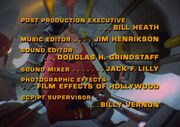
The word "SCRIPT" is misspelled
- The visual of the iron-silica planet from orbit is reused footage previously representing Alfa 177 in " The Enemy Within " and M-113 in " The Man Trap ". This planet effect was reused again as Argus X in " Obsession " and Ardana in " The Cloud Minders ".
- The footage of the two Lazaruses fighting was created by filming two stuntmen fighting in a smoke-filled room with orange and purple walls, then double-exposing its color negative footage over an astronomical photograph of the Trifid Nebula . ( citation needed • edit ) By actual count Lazarus changes between the universes about eight times.
- In the closing credits of the show, the title billing for Script Supervisor is misspelled "SCPIPT SUPERVISOR".
- Unique to the original series are the angle of the Enterprise as it fires its phasers to destroy Lazarus's ship, as well as the use of a single phaser beam and the lack of a sound effect when the beam is viewed from space.
Continuity [ ]
- In the opening scene Spock describes the planet as having an " oxygen-hydrogen atmosphere ". Such an atmosphere is practically impossible since a single spark would ignite it, perhaps even explosively.
- This is the first time that live two-way communication with Starfleet Command is depicted. In previous episodes, communication with Starfleet Command was through delayed radio messages.
- Depending on which version of this episode you watch, the closing stills change. The original syndicated version and the VHS version show the still as the Enterprise leaving the Earth-like planet from " Miri ", however, the Sci-fi Channel and DVD version show the still as just a blue planet, possibly Rigel 12 from " Mudd's Women " or Starbase 11 from " Court Martial ".
Reception [ ]
- The Agony Booth website included this episode among "The Worst of Trek ". In their recap, they write that in the episode, " very little actually happens, and what little that does comes about only because Kirk and Company are written to act in such a way that can only be described as severely brain damaged. " The reviewer continues, " I never thought I'd say this, but this episode is making " Spock's Brain " look pretty goddamn good right about now! " He concludes, " this is one of the most poorly constructed fifty minutes I've ever seen. An almost impossibly incoherent script, a damp squib of a finale, and some horrible editing make this one of the true stinkers in the Trek universe. " Also, he mentions that " [John Drew] Barrymore didn't show up for filming. Given the script, I can't say I blame the fellow. The rest of the cast should have done the same thing, to be perfectly frank. " [3]
Remastered information [ ]
"The Alternative Factor" was the forty-ninth episode of the remastered version of The Original Series to air. It premiered in syndication on the weekend of 1 December 2007 and aside from the standard CGI replacement footage of the Enterprise and the planet-of-the-week, this episode also featured several new, modest effects shots of the alternative warp effect, as well as phaser and transporter effects.

Video and DVD releases [ ]
- Original US Betamax release: 1985
- UK VHS release (two-episode tapes, CIC Video ): Volume 11 , catalog number VHR 2295, release date unknown
- US VHS release: 15 April 1994
- UK re-release (three-episode tapes, CIC Video): Volume 1.7, 4 November 1996
- Original US DVD release (single-disc): Volume 10, 21 March 2000
- As part of the TOS Season 1 DVD collection
- As part of the TOS Season 1 HD DVD collection
- As part of the Star Trek: Fan Collective - Alternate Realities collection
- As part of the TOS Season 1 Blu-ray collection
Apocrypha [ ]
- A cat version of "The Alternative Factor" was featured in Jenny Parks ' 2017 book Star Trek Cats .
Links and references [ ]
Starring [ ].
- William Shatner as Capt. Kirk
Also starring [ ]
- Leonard Nimoy as Mr. Spock
Guest star [ ]
- Robert Brown as Lazarus / anti-Lazarus
Featuring [ ]
- DeForest Kelley as Dr. McCoy
- Janet MacLachlan as Charlene Masters
- Nichelle Nichols as Uhura
- Richard Derr as Barstow
- Arch Whiting as Assistant Engineer
- Christian Patrick as Transporter Chief
- Eddie Paskey as Lesley [sic]
Uncredited co-stars [ ]
- William Blackburn as Hadley
- Vince Cadiente as security lieutenant/technician
- Frank da Vinci as Brent
- Carey Foster as sciences crew woman
- Tom Lupo as security guard
- Ron Veto as Harrison
- Command crewman
- Command crew woman
- Crew woman 1
- Crew woman 2
- Helmsman lieutenant
- Lieutenant 1
- Lieutenant 2
- Navigator lieutenant commander
- Sciences lieutenant
Stunt doubles [ ]
- Bill Catching as stunt double #2 for Robert Brown
- Gary Combs as stunt double for William Shatner
- Al Wyatt as stunt double #1 for Robert Brown
References [ ]
abrasion ; accusation ; all hands ; " all right "; alternative ; alternative warp ; analysis ; annihilation ; answer ; antimatter ; antimatter universe (aka minus universe ; negative universe ) assistant ; " at a loss for words "; " a thing "; atmosphere ; bait ; bandage ; battle stations ; being ; black ; blindness ; body temperature ; " Bones "; bruise ; bull ; captivity ; cartographic section ; censure ; civilization ; Code Factor 1 ; coffee ; commodore ; computer bank ; computer report ; constitution ; container ; contact ; country doctor ; course ; creature ; danger ; deaf ; death ; devil ; dilithium (aka dilithium crystal ); dimension ; dinosaur ; dizziness ; door ; double-talk ; drill ; Earth ; effect ; electrical impulses ; emptiness ; enemy ; energizer / energizing circuits ; energy ; eternity ; evidence ; existence ; experimentation chamber ; explosives ; face ; fact ; Fahrenheit ; fire ; footprint ; forehead ; formula ; freedom ; general alert ; " get to the point "; gravimetric field ; gravity ; guest ; head ; heart ; heaven ; Hell ; hole ; hour ; Human ( Human being ); humor ; hydrogen ; idea ; inch ; indignation ; information ; invasion ; iron ; joke ; justice ; key ; Lazarus' planet ; Lazarus' planet system ; Lazarus' spaceship ; liar ; lie ; life object ; life survey ; living being ; living creature ; location ; logic ; " lost his mind "; madman ; madness ; magnetic communication satellite ; magnetic effect ; magnetic field ; main screen ; mass ; matter ; matter universe (aka positive universe ) medic ; mental state ; Milky Way Galaxy ; mind ; minute ; miracle worker ; mission ; monster (aka beast ); movement ; muscleman ; negative magnetic corridor ; " not hold water "; object ; " of course "; orbit ; ounce ; " out of the question "; oxygen ; pain ; parallel universe ; paranoia ; parsec ; patient ; phaser bank ; phenomenon ; photographic section ; physical law ; physical makeup ; physical warp ; pleasure ; poetry ; powder keg ; power ; priority one ; prison ; pulsation phenomenon ; quadrant ; question ; radiation ; range ; rationality ; recuperative powers ; red 2 message ; report ; riddle ; rip in the universe ; rock ; safety valve ; screening ; search ; search party ; second ; section ; security red ; security team (aka security detail ); self-preservation ; sense of humor ; sensor ; ship's physician ; silica ; space ; spaceship ; speculation ; " stand by "; Starbase 200 ; Starfleet Command ; " strong as a bull "; surface ; terrain ; thing ; threat ; throat ; time chamber ; time ship ; time traveler ; trick ; truth ; understatement ; unit ; universe ; vengeance ; visual section 988-TG ; water ; weapon ; white ; word ; wound ; year ; zero gravity
Unreferenced materials [ ]
biological lab ; chemoscientist ; Riddle, Larry ; rose
External links [ ]
- "The Alternative Factor" at StarTrek.com
- " The Alternative Factor " at Memory Beta , the wiki for licensed Star Trek works
- " The Alternative Factor " at Wikipedia
- [4] "The Alternative Factor" at IMDB.com
- " The Alternative Factor " at MissionLogPodcast.com , a Roddenberry Star Trek podcast
- 1 Abdullah bin al-Hussein
The Mirror Universe in Star Trek Television, Explained
A fascinating and twisted reflection of the regular timeline of the Star Trek universe across four shows.
Created by Gene Roddenberry in 1966, the space adventure franchise Star Trek has endured for generations, spawning dozens of series, movies, and video games, with more related projects in the works. It has featured breezy and comedic episodes, but has also explored sensitive topics like fundamentalism, cloning, mental health, addiction, xenophobia, A.I. control, and bioweapons.
As a staple of science-fiction television, Trek shows have naturally tackled time travel , supernatural beings, noncorporeal lifeforms, space anomalies, and alternative or parallel universes . One of the latter was dubbed the Mirror Universe by fans, and here is how it came to be and what it entails. To clarify, when referring to this particular type of universe, the main timeline and its characters are labeled “Prime,” while their counterparts are slapped with the “Mirror” designation.
Stream Star Trek on Paramount+
The Mirror Premise at a Glance
In the Prime timeline , most humans aim to live in harmony with as many contacted alien species as possible; the main objective is building a universe of peace and tolerance, where medical advances can cure almost every ailment and injury, and special abilities and superpowers are celebrated and harnessed instead of feared and condemned. As Captain Picard explains to a man from the past:
The acquisition of wealth is no longer the driving force in our lives. We work to better ourselves and the rest of humanity.
Although populated with the same characters and occupying the same space, the Mirror Universe is set in another dimension, and features twisted or strange doppelgängers. Instead of avoiding mass destruction and preaching acceptance, the ruling Terran Empire is a ruthless, fascist regime that goes to great lengths to oppress and subjugate every species.
It even treats its own people in the same manner, punishing officers who commit “mistakes” with a device called the Agonizer, or putting them in the Agony Booth, and mercilessly eliminating any opponents and obstacles. Sometimes, Prime characters venturing into the Mirror Universe can prove beneficial. In Star Trek: Discovery , for instance, an adventure in the alternate timeline helps put an end to the war with the Klingons .
Related: 21 Ways Star Trek Predicted the Future
Another example is when Prime characters in Star Trek: Deep Space Nine influence evil doppelgängers into a change of conscience, leading to political reforms. Unfortunately, it is later revealed that the Terran Empire is overthrown, only to be replaced by an alliance of Klingons, Cardassians, and Bajorans, who enslave both humans and Vulcans.
It's important to note that Mirror characters are not only often polar opposites personality-wise, but they also have subtle biological differences, such as more sensitive eyesight, and they experience faster cellular decay when they stay in the Prime Universe for too long.
Canon Shows with Mirror Universe Episodes
Before diving into the explanation of the Mirror Universe, here is a breakdown of the four canon series of Star Trek that feature this parallel dimension:
Star Trek: The Original Series (1966-1969)
Honorable Mention: The Tholian Web: Technically not set in the Mirror Universe, it features the vanishing of the USS Defiant into Tholian space, and the connection to a parallel dimension is established later on, in Star Trek: Enterprise ’s episode, “In a Mirror, Darkly.”
These are the voyages of the starship Enterprise. Its five-year mission: to explore strange new worlds, to seek out new life and new civilizations, to boldly go where no man has gone before.
Set in the 23d century, The Original Series (TOS) follows Captain James T. Kirk (William Shatner) and his crew, namely First Officer and Science Officer Spock (Leonard Nimoy), Chief Medical Officer Leonard McCoy (DeForest Kelley), Chief Engineer Scott (James Doohan), and Communications Officer Lt. Nyota Uhura (Nichelle Nichols), as they explore the Milky Way and interact with various lifeforms, some more hostile than others.
Star Trek: Deep Space Nine (1993-1999)
Star trek: deep space nine.
Deep Space 9 (DS9) is set in the 24th century, and centers on the titular space station located at the end of the galaxy, next to a wormhole connecting Federation space to the Gamma Quadrant. Main characters include Captain Benjamin Sisko (Avery Brooks), Science Officer Jadzia Dax (Terry Farrell), Head of Security Odo (René Auberjonois), Chief Medical Officer Julian Bashir (Alexander Siddiq), and First Officer Kira Nerys (Nana Visitor).
Together, they protect the Alpha Quadrant from hostile species like the Cardassians and the ultimate rulers of the Gamma Quadrant, the Changelings, who are fluidic shapeshifters.
Star Trek: Enterprise (2001-2005)
Star trek: enterprise.
Enterprise (ENT) serves as a 22nd-century prequel to TOS , centering on Captain Jonathan Archer (Scott Bakula) and his crew in the first-ever exploration of the Alpha and Beta quadrants under the flag of the United Earth, aboard the Enterprise NX-01. They save the Earth from the hostile Xindi aliens, establish the guidelines for interstellar diplomacy, and usher in the formation of the United Federation of Planets. It’s basically a prequel to the entire Prime timeline.
Star Trek: Discovery (2017 –)
Star trek discovery.
Discovery (DIS) follows the crew of the titular starship in the 23rd century, a decade before TOS , and later into the 32nd century, after they time travel. Sonequa Martin-Green stars as Michael Burnham, a science officer who starts a war with the Klingon race and then becomes captain of the Discovery . Another key character is her mentor, Philippa Georgio ( wonderfully played by Michelle Yeoh ), the friendly, honorable, determined, and decorated commanding officer of the USS Shenzhou ; she is killed in hand-to-hand combat with a Klingon leader.
The Episode That Ushered in the Narrative
In TOS ’ episode “Mirror, Mirror,” the transporter malfunctions during an ion storm and swaps Captain Kirk and the rest of his landing party, McCoy, Scott, and Uhura, with their villainous counterparts from a parallel universe that exists in the same space. This alternate dimension sees the Federation’s USS Enterprise , now called the ISS Enterprise , as a flagship for the evil Terran Empire.
Disoriented at first, Prime team members decide to play along until they’re able to recreate the same conditions that would send them back home. Before leaving, Prime Kirk reveals to Mirror Spock the existence of the Tantalus Field, Mirror Kirk’s secret device that can monitor and eliminate people with a single touch, so that he can use it as he sees fit to reform the Empire.
It is revealed that Mirror Kirk used the deadly device to get rid of his predecessor, Mirror Captain Pike, in order to take over the ISS Enterprise ; that alone was shocking to both Prime Kirk and the audience, because it was completely out of character for the Kirk we knew, and cemented the darker aspect of the Mirror Universe as a whole.
Related: 23 Coolest Alien Characters in the Star Trek Franchise
The Tantalus Field makes a comeback in the DIS episode “Terra Firma,” when it is revealed that Mirror Georgiou, the Emperor of the Terran Empire, has been using it to spy on her adopted daughter, Mirror Captain Burnham.
To date, “Mirror, Mirror” is still considered the best Mirror episode in the franchise. It is a well-executed, insightful, and intriguing plot, featuring a particularly ruthless Kirk and an edgier Spock. No wonder it became a defining moment in classic pop culture and inspired fans to come up with the Mirror Universe designation in future related chapters.
Three Fan-Favorite Mirror Characters
TOS ’ Mirror Spock and DS9 ’s Mirror Kira left a particularly memorable impression.
Mirror Spock is a Terran/Vulcan hybrid and First Officer of the ISS Enterprise . Unlike the clean-shaven Prime Spock, who is inclined to self-sacrifice for the greater good, he sports a cool mustache and a goatee and ruthlessly resorts to punishment and torture, even with his subordinates. However, much like his counterpart, he is governed by logic, and thus, Prime Kirk is able to reason with him and influence him for the good of the Empire, and our heroes.
Mirror Spock: Captain, I am pleased that you frustrated Mr. Chekov’s plan. I should regret your death. Prime Kirk: Why? Mirror Spock: I do not desire the captaincy. I much prefer my scientific duties, and I am frankly content to be a lesser target. Prime Kirk: Logical, as always, Mr. Spock.
Fun Fact: Mirror Spock inspired the name for the progressive metal group, Spock’s Beard.
While Prime Kira is a compassionate Bajoran and an honorable Major (and later Colonel) who dresses modestly and fights for injustice, Mirror Kira is the ultimate femme fatale , black leather outfit and whip included. She holds the title of Intendant in the Klingon-Cardassian Alliance and is playful, manipulative, and hedonistic, with a twisted sense of humor.
When she comes face to face with Prime Kira, she is so fascinated by her counterpart that Mirror Kira professes her attraction to Prime Kira: a classic case of narcissism.
Mirror Kira: You know, I bet if we put our heads together, we could create a little excitement for ourselves. Terran Guard: You sentenced my wife to death. Mirror Kira: Isn't that a coincidence? I was hoping you weren’t married.
Other noteworthy Mirror characters are Mirror Philippa Georgiou, and Mirror Captain Gabriel Lorca. Georgiou is a complicated villain who starts off as the ruthless tyrannical ruler of the Terran Empire, and ends up in the Prime Universe as a prisoner, working for the Federation, who utilizes her vast skills in war to aid them. Georgiou gets a fascinating redemption arc as a villain through the seasons of Discovery, and her eventual experience of cell degeneration in the Prime Universe leads her to be sent into the past, before the two universes split apart.
And Captain Lorca is the compelling character in the first season of Discovery played incredibly well by Jason Isaacs ( Harry Potter , The Patriot ), who is hiding in the Prime Universe disguised as his Prime counterpart. He seeks to overthrow Georgiou and rule the Mirror Universe with Burnham at his side, though he was also one of the few Mirror Universe characters who showed a surprising amount of warmth and humanity, in rare moments.
Will there be more Mirror episodes in the franchise? The answer may very well lie in the upcoming seasons of DIS and Star Trek: Strange New Worlds. Perhaps more Prime characters will emerge as their secret Mirror counterparts in disguise, as was the case of DIS ' Gabriel Lorca (Jason Isaacs), the power-hungry Captain in the Terran Imperial Starfleet who infiltrated and took command of the USS Discovery in the main timeline.
Meanwhile, all eyes are on the much-anticipated movie, Star Trek: Section 31 ; it will be directed by Olatunde Osunsanmi, with Michelle Yeoh reprising her role of Philippa Georgiou as a member of the shady titular intelligence organization.
Log in or Sign up
You are using an out of date browser. It may not display this or other websites correctly. You should upgrade or use an alternative browser .
Alternate Universes in TOS
Discussion in ' Star Trek - The Original & Animated Series ' started by MAGolding , Oct 7, 2021 .
MAGolding Fleet Captain Fleet Captain
This is a sort of a reply to post number 5375 in the thread: https://www.trekbbs.com/threads/what-are-your-controversial-star-trek-opinions.304751/page-269 It is my belief that the only logical way to look at highly episodic and non serialzed tv series, such as the earlier Star Trek tv shows, is to picture every single episode, except for episodes which are clearly prequels and sequals to eachother, happens in an alternate universe of its their own, separate from the alternate universes of every other episode. The pilot episode and/or the first episode, dempinding on how much tey set up the preimise of the show, might be prequels to all other episodes. Thus each episode would then exist in a separate alternate universe with itself and only the pilot episode, except for the few episodes which would be sequels to one episode, which would exist in 3 epsisode alernate universes. I watched a number of episodes from old western shows from the 1950s and 1960s a few years ago and noticed how little continutity and serialization they, and presumably other tv shows of the period, had. Episodes of Stories of the Century and Tales of Wells Fargo had their protagonists take part in events decades apart without aging noticably. One episode of Tales of Wells Fargo had to happen both before 1861 and after 1879, which would be imposible. The dates when given in various Maverick episodes do not get later in later episodes, but instead jump around in time within seasons and between seasons. The creators of Maverick didn't bother to give episodes fictional dates consistent with the order in which they were produced or broadcast. Considering how few railroad there were in the west and how slow travel was during the 1870s, I find it hard to believe that the Mavericks could have traveled to all the widely separated places they visited without seeming to age a lot more. I once read that there are date contradictions in Have Gun, Will Travel. Gene L. Coon wrote for Maverick and Have Gun, Will Travel, and Gene Roddenberry wrote for Have Gun, Will Travel. And I don't think that the crime shows, dramas. medical shows, sitcoms, etc. they wrote for paid much more attention to chronology and continuiity. So I think that we should assume that most tv shows, except for serialized ones, happen in a number of alternate universes. Most episodes may happen in alternate universe all to themselves, or with the pilot episode if any, and only a few episodes will be sequels and prequels to each other and happen in the same universe. TOS actually had more continuity than most shows in its era, but far too little for any one to assume that every TOS episode happens in the same alternate universe. Examples of TOS episodes being sequels to other episodes, except maybe for the pilots "the Cage" and "Where No Man Has Gone Before" are far and few between. iIn the last episode "Turnabout Intruder" Kirk in the body of Dr. Lester mentioned events "The Tholian Web" and "The Empath" making Turnabout Intruder" a sequel to those episode. In "By Any Other Name" events in "A Taste of Armageddon" and "Where No Man Has Gone Before" are mentioned, though it is possible that all TOS episodes are sequels to "Where No Man Has Gone Before" anyway. I note that what later became known as the Vulcan Mind Meldt was first introduced in "Dagger of the Mind". But the way Spock talked about it in "A Taste of Armageddon" hinted that it might not be a sequel to "Dagger of the Mind". So possibly Dagger of the Mind" happens in an alternate universe to "A Taste of Armageddon" and "By Any Other Name". And other Vulcan MInd Meldepisodes might be sequels to either "Dagger of the Mind" or A Taste of Armageddon" or neither. In "That Which Survives" events in "The Devil in the Dark" are mentioned. "I, Mudd" is a sequel to "Mudd's Women". Chekov doesn't know about Harry Mudd in "I, Mudd", but does know about corbomite from "The Corbomite Maneuver" in "The Deadly Years", which is probably a sequel to " Balance of Terror". Star trek II: The Wrath of Khan apparently shows that checkov met Khan offscreen during "Space Seed" (Khan was a man from centuries ago, so everyone would want to meet him). Depending on the relative dating of "Mudd's Women", and "The Corbomite "maneuver", some people might speculate that "I, Mudd" & "Mudd's Women" happpen in a different alternate universe than "The Corbomite Maneuver', "Balance of Terror", "Space Seed'", and "The Deadly Years", with Chekov joining the crew at different times. And there are complex chronological problems with "Balance of Terror", "Space Seed', Star Trek II: The Wrath of Khan , and Star trek V: The Final Frontier , and one solution would be if Balance of Terror" and "Space Seed', are in alternate universes. Thus one might specfulate that the alternate universe of "I, Mudd" & "Mudd's Women" branches off from the alternate universe of "The Corbomite Maneuver', which later, after "The Corbomite Maneuver", branches off into an alternate universe with "Balance of Terror" and "the Deadly Years" and another alternate universe with "Space Seed', Star trek II: The Wrath of Khan , and Star trek V: The Final Frontier , A Klingon-Federation war erupts in "Errand of Mercy", but the Organians enforce peace at the end. "The Trouble With Tribbles" memtions the Organian Peace Treaty so is probably a sequel to "Errand of Mercy". A Klingon treaty is mentioned in "A Private little War" and in "Day of the Dove", so they might also be sequels to."Errand of Mercy". Other Klingon episodes like "Friday's Child" and "Elain of Troyius" might be sequels to "Errand of Mercy" or happen in alternate universes wherre the Klingon War never started. Star Trek: The Animated Series had several sequels to TOS episodes. "One of Our Planets is MIssing " may be a sequel to "The Ultimate Computer". "More Tibbles, More Troubles" is a sequel to "The Trouble With Tribbles". "Once Upon a Planet" is a sequel to "Shore Leave". "Mudd's Passion" is a sequel to "Mudd's Women", and "I, Mudd". "The Time Trap" features Klingon Commander Kor, and so may be a sequel to "Errand of Mercy". In "The Survivor" the Romulan Commander tells Kirk: ROMULAN [on viewscreen]: You appear to have a propensity for trespassing in the Neutral Zone, Captain Kirk. Click to expand...
Spock's Barber Commodore Commodore
That’s the second longest post I’ve ever seen.
1001001 Serial Canon Violator Moderator
MAGolding said: ↑ It is my belief that the only logical way to look at highly episodic and non serialzed tv series, such as the earlier Star Trek tv shows, is to picture every single episode, except for episodes which are clearly prequels and sequals to eachother, happens in an alternate universe of its their own, separate from the alternate universes of every other episode. Click to expand...
Serveaux Fleet Admiral Premium Member
MAGolding said: ↑ This is a sort of a reply to post number 5375 in the thread: https://www.trekbbs.com/threads/what-are-your-controversial-star-trek-opinions.304751/page-269 It is my belief that the only logical way to look at highly episodic and non serialzed tv series, such as the earlier Star Trek tv shows, is to picture every single episode, except for episodes which are clearly prequels and sequals to eachother, happens in an alternate universe of its their own, separate from the alternate universes of every other episode. The pilot episode and/or the first episode, dempinding on how much tey set up the preimise of the show, might be prequels to all other episodes. Thus each episode would then exist in a separate alternate universe with itself and only the pilot episode, except for the few episodes which would be sequels to one episode, which would exist in 3 epsisode alernate universes. I watched a number of episodes from old western shows from the 1950s and 1960s a few years ago and noticed how little continutity and serialization they, and presumably other tv shows of the period, had. Episodes of Stories of the Century and Tales of Wells Fargo had their protagonists take part in events decades apart without aging noticably. One episode of Tales of Wells Fargo had to happen both before 1861 and after 1879, which would be imposible. The dates when given in various Maverick episodes do not get later in later episodes, but instead jump around in time within seasons and between seasons. The creators of Maverick didn't bother to give episodes fictional dates consistent with the order in which they were produced or broadcast. Considering how few railroad there were in the west and how slow travel was during the 1870s, I find it hard to believe that the Mavericks could have traveled to all the widely separated places they visited without seeming to age a lot more. I once read that there are date contradictions in Have Gun, Will Travel. Gene L. Coon wrote for Maverick and Have Gun, Will Travel, and Gene Roddenberry wrote for Have Gun, Will Travel. And I don't think that the crime shows, dramas. medical shows, sitcoms, etc. they wrote for paid much more attention to chronology and continuiity. So I think that we should assume that most tv shows, except for serialized ones, happen in a number of alternate universes. Most episodes may happen in alternate universe all to themselves, or with the pilot episode if any, and only a few episodes will be sequels and prequels to each other and happen in the same universe. TOS actually had more continuity than most shows in its era, but far too little for any one to assume that every TOS episode happens in the same alternate universe. Examples of TOS episodes being sequels to other episodes, except maybe for the pilots "the Cage" and "Where No Man Has Gone Before" are far and few between. iIn the last episode "Turnabout Intruder" Kirk in the body of Dr. Lester mentioned events "The Tholian Web" and "The Empath" making Turnabout Intruder" a sequel to those episode. In "By Any Other Name" events in "A Taste of Armageddon" and "Where No Man Has Gone Before" are mentioned, though it is possible that all TOS episodes are sequels to "Where No Man Has Gone Before" anyway. I note that what later became known as the Vulcan Mind Meldt was first introduced in "Dagger of the Mind". But the way Spock talked about it in "A Taste of Armageddon" hinted that it might not be a sequel to "Dagger of the Mind". So possibly Dagger of the Mind" happens in an alternate universe to "A Taste of Armageddon" and "By Any Other Name". And other Vulcan MInd Meldepisodes might be sequels to either "Dagger of the Mind" or A Taste of Armageddon" or neither. In "That Which Survives" events in "The Devil in the Dark" are mentioned. "I, Mudd" is a sequel to "Mudd's Women". Chekov doesn't know about Harry Mudd in "I, Mudd", but does know about corbomite from "The Corbomite Maneuver" in "The Deadly Years", which is probably a sequel to " Balance of Terror". Star trek II: The Wrath of Khan apparently shows that checkov met Khan offscreen during "Space Seed" (Khan was a man from centuries ago, so everyone would want to meet him). Depending on the relative dating of "Mudd's Women", and "The Corbomite "maneuver", some people might speculate that "I, Mudd" & "Mudd's Women" happpen in a different alternate universe than "The Corbomite Maneuver', "Balance of Terror", "Space Seed'", and "The Deadly Years", with Chekov joining the crew at different times. And there are complex chronological problems with "Balance of Terror", "Space Seed', Star Trek II: The Wrath of Khan , and Star trek V: The Final Frontier , and one solution would be if Balance of Terror" and "Space Seed', are in alternate universes. Thus one might specfulate that the alternate universe of "I, Mudd" & "Mudd's Women" branches off from the alternate universe of "The Corbomite Maneuver', which later, after "The Corbomite Maneuver", branches off into an alternate universe with "Balance of Terror" and "the Deadly Years" and another alternate universe with "Space Seed', Star trek II: The Wrath of Khan , and Star trek V: The Final Frontier , A Klingon-Federation war erupts in "Errand of Mercy", but the Organians enforce peace at the end. "The Trouble With Tribbles" memtions the Organian Peace Treaty so is probably a sequel to "Errand of Mercy". A Klingon treaty is mentioned in "A Private little War" and in "Day of the Dove", so they might also be sequels to."Errand of Mercy". Other Klingon episodes like "Friday's Child" and "Elain of Troyius" might be sequels to "Errand of Mercy" or happen in alternate universes wherre the Klingon War never started. Star Trek: The Animated Series had several sequels to TOS episodes. "One of Our Planets is MIssing " may be a sequel to "The Ultimate Computer". "More Tibbles, More Troubles" is a sequel to "The Trouble With Tribbles". "Once Upon a Planet" is a sequel to "Shore Leave". "Mudd's Passion" is a sequel to "Mudd's Women", and "I, Mudd". "The Time Trap" features Klingon Commander Kor, and so may be a sequel to "Errand of Mercy". In "The Survivor" the Romulan Commander tells Kirk: So maybe "The Survivor" is a sequel to the animated episode "The Practical Joker" - even though "The Practical Joker" was broadcast after "The Survivor". Maybe "The Survivor" was a sequal to one or more TOS episodes where the Enterprise entered the Neutral Zone like "The Deadly Years", "The Enterprise Incident", and "The Way to Eden". The main set of TOS episodes whch are sequels to others can be deduced from episodes of TNG, DS9, and VOY which are sequels to TOS movies and episodes. Every other TNG epsisode should be a sequel to "Encounter at Farpoint". Every DS9 episode should be a sequel to "Emissary". Since "Emissary" is a sequel to the TNG episodes "The Best of Both Worlds" and "The Best of Both Worlds Part 2", all DS9 episodes are sequels to "Encounter at Farpoint" and "The Best of Both Worlds" and "The Best of Both Worlds Part 2". All VOY episodes should be sequels to "Caretaker". Since "Caretaker" is a sequel to "Emissary", all VOY episodes must be sequels to "Emissary", "Encounter at Farpoint", and "The Best of Both Worlds" and "The Best of Both Worlds Part 2". So all TNG, DS9, and VOY episodes should be sequels to "Encounter at Farpoint". If any TNG, DS9, or VOY episode is a sequel to a TOS episode or movie, "Encounter at Farpoint" must be a sequel to that TOS episode or movie. And thus every episode of TNG, DS9, and VOY must be a sequel to that TOS episode or movie. The VOY episode "Flashback" was a sequel to Star Trek VI:The Undiscovered Country , thus making every TNG, DS9, & VOY episode a sequel to Star Trek VI:The Undiscovered Country. In Star Trek VI:The Undiscovered Country someone says "We're dead" and Spock says "I've been dead before". And that seems like a clear reference to the events of Star Trek II: The Wrath of Khan , Star Trek III: The Search for Spock , and Star Trek IV: The Voyage Home . Thus Star Trek VI seems like a clear sequel to Star Trek II, Star Trek III , and Star Trek IV . In Star Trek VI:The Undiscovered Country Chang says that Kirk was demoted from admiral to captain, which seems like a clear reference to Star Trek IV: The Voyage Home , making Star Trek VI a sequel to Star Trek IV . In Star Trek V: The Final Frontier Kirk says that he lost a brother once. And the first time they hear that, all fans of TOS naturally assume that Kirk is talking about the death of Sam Kirk in "Operation - Annihilate!" but Kirk continues to say he was lucky and got his brother back. And that should be a reference to the events of Star Trek II: The Wrath of Khan , Star Trek III: The Search for Spock , and Star Trek IV: The Voyage Home. So "Encounter at Farpoint" and all TNG, DS9, and VOY episodes should be sequels to the movie sequence of Star Trek II, Star Trek III , and Star Trek IV . Star Trek V: The Final Frontier also seems like a sequel to Star Trek II, Star Trek III , and Star Trek IV . But it is uncertain whether Star Trek V: The Final Frontier happens in the same alternate universe as Star Trek VI:The Undiscovered Country and thus in the same universe as all TNG, DS9, and VOY episodes. And it is possible that Kirk's statement in Star Trek V: The Final Frontier means the film is also a sequel to "Operation - Annihilate!", which would make Star Trek II: The Wrath of Khan and all episodes of TNG, DS9, and VOY sequels to "Operation - Annihilate!". Star Trek II: The Wrath of Khan is obviously a sequel to "Space Seed", making all TNG, DS9, and VOY episodes sequels to "Space Seed", as well as possibly sequels to "Operation - Annihilate!". Earlier in this post, I discussed possible relationships of "Space Seed" with other TOS episodes and movies. So it is possible that "Space Seed" is a sequel to "The Corbomite Maneuver" but not a sequel to "I, Mudd" & "Mudd's Women" or to "Balance of Terror" and "the Deadly Years", and thus that the same would be true for all TNG, DS9, and VOY episodes. The TNG episodes "Unification part 1" and Unification part 2" also mention the Khitomer Conference in Star Trek VI:The Undiscovered Country , thus also making all TNG, DS9, and VOY episodes sequels to "Space Seed" and possibly to "The Corbomite Maneuver" and "Operation - Annihilate!". The DS9 episode "Trials and Tribble-ations" is a sequel to "The Trouble With Tribbles" which is a sequel to "Errand of Mercy". Events in "Arena" are also mentioned. Thus all TNG, DS9, and VOY episodes are sequels to "Arena", "Errand of Mercy", and "The Trouble with Tribbles", as well as "Space Seed" and possibly "The Corbomite Maneuver" and "Operation - Annihilate!". In the TNG episode "Relics" Scott mentions events from "The Naked Time", "Wolf in the Fold", and "Elaan of Troyius", thus all TNG, DS9, and VOY episodes are sequels to "The Naked Time", "Wolf in the Fold", and "Elaan of Troyius" as well as "Arena", "Errand of Mercy", "The Trouble with Tribbles", "Space Seed" and possibly "The Corbomite Maneuver" and "Operation - Annihilate!". The TNG epiosode "The Naked Now" is also a sequel to "The Naked Time". The DS9 episodes "Crossover', "Through the looking Glass", "Shattered Mirror", Resurrection", and "The Emperor's New Clak" are all sequels to the TOS episode Mirror, Mirror", thus all TNG, DS9, and VOY episodes are sequels to "Mirror, Mirror" as well as sequels to "The Naked Time", "Wolf in the Fold", "Elaan of Troyius", "Arena", "Errand of Mercy", "The Trouble with Tribbles", and "Space Seed", and possibly "The Corbomite Maneuver" and "Operation - Annihilate!". Therefore all TNG, DS9, and VOY episodes are sequels to (in no particular order): 1) "The Naked Time" 2) "Arena" 3) "Errand of Mercy" 4) "Space Seed" 5) "Mirror, Mirror" 6) "Wolf in the Fold" 7) "The Trouble with Tribbles" 8) "Elaan of Troyius" 9) Star Trek II: The Wrath of Khan 10) Star Trek III: The Search for Spock 11) Star Trek IV: The Voyage Home 12) Star Trek VI:The Undiscovered Country And maybe all TNG, DS9, and VOY episodes are sequels to "The Corbomite Maneuver" and "Operation - Annihilate!". And it is possible that all TOS episodes, and thus all TNG, DS9, and VOY episodes, are sequels to the TOS pilots "The Cage" and "Where No Man Has Gone before". So the TNG, DS9, and VOY episodes are sequels to 8 TOS episodes, and possibly sequels to another 4 TOS episodes,and they are sequels to 4 TOS movies. It is possible that the TNG, DS9, and VOY episodes are sequels to other TOS epsodes and movies. But considering all the dangers that Kirk & Co. face in those 12 to 16 TOS productions, and their extremely small statistically probability of surviving so many dangers, I see no reason to put them into even greater dangers in the alternate universe of "Encounter at Farpoint" by adding more TOS episodes and movies to that particular alternate universe. The Short Treks episode "Ephraim and Dot" has scenes from many TOS episodes. They appear in the order: 1) "Space Seed" 2) "The Trouble With Tribbles" 3) "The Naked Time" 4) "Who Mourns for Adonais?" 5) "The Doomsday Machine" 6) "The Tholian Web" 7) "The Savage Curtain" 8) Star Trek II: The Wrath of Khan 9) Star Trek III: The Search for Spock So in a Star Trek canon that includes "Ephraim and Dot", and when those episodes happen in the order they were shown in "Ephraim and Dot" instead of production order, stardate order, or airdate order, "Encounterat Fairpoint" and all the TNG, DS9, and VOY episodes would be sequels to 1) "Space Seed" ?) "Errand of Mercy" 2) "The Trouble With Tribbles" 3) "The Naked Time" ?) "Arena" 4) "Who Mourns for Adonais?" 5) "The Doomsday Machine" ?) "Mirror, Mirror" ?) "Wolf in the Fold" ?) "Elaan of Troyius" 6) "The Tholian Web" 7) "The Savage Curtain" 8) Star Trek II: The Wrath of Khan 9) Star Trek III: The Search for Spock 10) Star Trek IV: The Voyage Home 11) Star Trek VI:The Undiscovered Country And possibly also one or more of: The Cage", "Where No Man Has Gone before", "The Corbomite Maneuver", & "Operation - Annihilate!". So that would make Kirk & Co.have to survive the dangers in 16 to 20 TOS episodes and movies in the alternate universe including "Encounter at Farpoint" and thus in each of the countless alternate universes of various TNG, DS(, and VOY episodes branching off from "Encounter at Farpoint". And I see no eason to make their survival even more improbable by putting more TOS productions into the same alternate universe. Click to expand...
Neopeius Admiral Admiral
I made a similar supposition about Buffy. There comes a point when a series collapses under the weight of too many exciting adventures involving the same person. It became implausible in my beloved Rockford Files , and ridiculous in Magnum P.I. (really? that many murders on Oahu ?) We joked that Shinjuku is the CRIME CAPITAL OF THE WORLD based on Deathnote . Three seasons of Enterprise adventures already strains credulity. Five (including TAS) gets dicey. Add in all the books and the fanfic and the fan films (seriously, folks, take a cue from Exeter and show ships besides the Enterprise!) and it get stupid. In the same vein as the alternate universe theory, I've posited that the superfluity of Earths in Star Trek is because the galaxy is really a series of artificially duplicated systems, like shards in a kaleidoscope. They started all the same and then went off on different paths. Hey, it's as good an explanation as any... One quibble in your otherwise excellent post: "TOS actually had more continuity than most shows in its era, but far too little for any one to assume that every TOS episode happens in the same alternate universe. " Begging the question. The basic assumption of a serial episodic narrative, unless otherwise stated, is that all episodes take place in the same universe.
XCV330 ★ Premium Member
It is interesting that you have taken on a world-view for pre-serialized television that espouses that each distinct story takes place inside of its own universe. While this is in some ways a very antiseptic method for dealing inconsistencies, the realization of such a conglomerate field of storytelling is at once quioxitcally both highly ordered and threatens chaos. For without the idea of continuance, where is the viewer’s involvement in a narrative that they must understand has no bearing upon future or past events, at least none that they will ever be party to. And this brings up a more metaphysical question of whether the story itself has any value itself without the addition of the viewer. This is no chicken and egg problem for surely the third party missing in this discussion is the storyteller themselves who must , indeed thrives upon the interest and continued demand for his or her talent from the listener. The story is merely a product, just like: Poems Raisins Horseshoes Thermonuclear warheads Novels Wedding dresses Amazon Web Services EC2 on-demand virtualized load balanced hosting Wood Bass boats Film projectors and a few other things. If we take in the semiotic theory of Jakob von Uexkull, we must then return to the viewer and his or her umwelt, that is the sum total of the perception of their environments. In this we must also consider the time and place. For the viewer of a television program in, taking a random year, 1964, may be used to non-serialized productions on television, but they may also have been earlier in their life very familiar with serial productions shown in movie theaters. The shift has come and gone before. I believe there is enough flexibility in the mind of the average viewer of those days (many of whom were bald, but many of those equipped with hair also were not opposed to the wearing of various wigs, as this was an era where mass production of hair pieces reached a crescendo and in no way affected the viewing of television, unlike previous wigs which were known to spontaneously catch fire in small cramped movie theaters, immolating the wearer and their chums they brough to watch the films with them, screaming in agony and trying to put out the flames with their primitive unevolved crablike hands rather than use the beverages conveniently located nearby in the snack bar. But really, how could they do otherwise? Science was in its infancy and the nature of combustion was yet to be fully understood by the pioneering work of Robert Goddard and Catherine Bach. I daresay we would have all suffered such an inglorious demise in the same circumstances. So, it is understood that by the mid twentieth century, the average television viewer was aware of serialization, but had rejected it due to past technological risks as well as the social and political dangers of being associated with Marxist organizations connected to Hollywood. As well they should have. In an era were Lockheed Starfighters created patriotic sonic booms overhead every evening, and Eugene V. Debs was only a distant memory, one could take comfort in knowing that one could go bowling one week and miss one episode of the Fugitive, but come back to the family domicile and catch back up with the adventures of Dr. Richard Kimble and the rest of the crew of the starship Enterprise. For the act of viewing, listening, or reading, is an active one and the mind must be a participant. Where there is no continuity, continuity will be created. In a holographic universe these binding mind fleugotheurons are just as relevant as the the nature of space time itself upon a relativistic cosmos. I have a theory that shows how but I am feeling dyspeptic and I am not going to show anyone. Maybe later. If we assume no continuity in television, we must assume no continuity in the universe. And therefore each waking day is itself a reality unto itself, and each person is a realitiy unto themselves, and each moment down to the smallest angstrom of time curvature is in itself its own Hubble-sphere or continuity separated by incalculable distances from everything else, the edges of it all rubbing against each other like creepy men in a subway. The train, not the line at a sandwich franchse though I suppose that works too. If we create our own reality, why do they tend to suck so much? If I may be allowed to be a bit of a classist for a moment, let us consider what Lucretius pens regarding this: Thus too, if all things are create of four, And all again dissolved into the four, How can the four be called the primal germs Of things, more than all things themselves be thought, By retroversion, primal germs of them? For ever alternately are both begot, With interchange of nature and aspect From immemorial time. But if percase Thou think'st the frame of fire and earth, the air, The dew of water can in such wise meet As not by mingling to resign their nature, From them for thee no world can be create- No thing of breath, no stock or stalk of tree: In the wild congress of this varied heap Each thing its proper nature will display, And air will palpably be seen mixed up With earth together, unquenched heat with water. -De Rerum natura, Book 1, beginning like 763 I think that speaks for itself. Now getting past, if we must, accepting things for the things they are not trying to extrapolate beyond, lets us get back to the slowly tumescing wrinkly little nub of the gist and continue: Because there are examples of continuity even in non-serialized productions. Sometimes those are caused by circumstances, most often changes in the acting positions. In Fresh Prince of Bel-Air, when Wil Smith acknowledges that his aunt Vivian now looks different than she did before, is he really breaking the fourth wall, as bit of humor to the audience, or is he actually breaking a fifth wall and using the change in actors from Janet Hubert to Daphne Maxwell Reed using the vibration of his voice and the considerable power of his mind to rend a tear in the fabric of Bel-Airs reality opening a portal between past and present universes. That he did not succeed (or did he?) is not surprising considering the extraordinary amount of funkiness and energy that would have been required, but that he did get so close succeeding was no doubt part of his incredible charm, mastery of certain metaphysical practices of the ancient Egyptians, having a palm pilot hidden in his pocket, and his close association with Tommy Lee Jones, who himself served aboard the Starship Enterprise in a later rendition of The Fugitive. It must also be remembered that Will Smith played a character named Will Smith, and thus came prepared into this limited multiverse than anyone else could have before or since. Also it made Nicky Banks become a regular character, and not recurring. So now there is irrefutable proof that characters within their own series are aware of the limited nature of the umwelt to which they exist in. This was quite common, as well, in animated cartoons, except for Star Trek the Animated Series, which showed absolutely no self-awareness or it might have been better. Was it too much to ask for a TAS/Land of the Lost crossover? Is Doohan himself a character who plays officers in space, and thus Scotty is also on Jason of Star Command? These are side subjects but worth exploring in more detail at some point. We discussed breaking of the fourth wall, previously, but since this is a forum dealing with Star Trek, it should be noted that within Star Trek such things are very rare. Still, McCoy did it, and therefore a purist of the The Original Series may take this to understand that while we are aware of Star Trek, McCoy is aware of us. Dr. McCoy is now both the story teller and the viewer and we are the viewed. Therefore we ourselves have become a product such as : Rotary ammunition magazines Potatoes Space capsules The stuff you use to make flans Margaret Atwood Ear buds Books about airplanes But not a service. If every episode exists in its own reality than that reality itself is permeable, like a squishy membrane between two lukewarm slowly melting walls in a house made of gelatin. Yes, you could escape from it, but everyone loves Jello and so no one will bother. We accept things for what they are and add the details in our mind in the mind’s own post production. Indeed, perhaps everything is realily akin to the Advaita-Vedanta ideal of the illusory nature of reality, and the nonduality of everything. “There is neither creation nor destruction, neither destiny nor free will, neither path nor achievement. This is the final truth.” -Ramana Maharshi Though one might counter with: That's why I get glad when I hear somebody smoked that ass (*gunshot*) Just to let ya know how I feel Word em up, the fuckin' shit is real Hey yo, it's real Aiyyo the shit is real Aiyyo it's real Word up, the shit is real -Fat Joe , This Shit is Real Therefore it is real but it is only real within its own understanding of realness as a construct of Maya, the play of the Gods. Fat Joe saw this shit, and decided it was real. Ramana Maharshi was not disputing the nature of the reality of this shit but rather showing a new way of looking at that nature of the nature itself. It must be noted that scholars have determined however that Fat Joe did not get any true cred until he beat up a man with a baseball bat to seal a gold chain in 1998, long past the beginnings of the normalization of serialization in television. This was an era of extreme violence and dispute between East Coast rappers and west coast screenwriters. The great learning centers of India, Rome, Greece and Toronto had shut their doors against this rising tide of intellectual luddism. Deep Space Nine was one, replaced by Voyager which proudly used the reset button, which exulted like a bonobo touching its own filthy private parts in the duality of every episode having a reset button, of every episode being out of continuity with the previous. “Don’t you understand? It is real.” -Benny Russell And yet as I say, such continuities leaked through even the staunchest avoiders of continuity. Hunter, the police procedural on NBCs in the 1980’s and early 90’s sometimes seemed to ignore major incidents that happened to its characters, only to remember them later. Of course this series experienced a revival in 2003, but like fruitcake hurled in an angry rage by relatives through a bathroom window while one is sitting on the commode trying to have a difficult bowel movement, it arrived unbidden, unwelcome, unasked for and made of fruitcake. You either like it or you don’t. But it’s worth trying. Fruitcake has become one of those things that become more known by a reputation than by active tasters. To quote Dr. Seuss “Try them. You might like them.” Having said that I was never really a big fan of them, but I will admit it did not make me ill the last one I tasted. I did not enjoy it either. Our primitive unevolved ancestors had tastebuds that were arranged quite differently from the ones we enjoy now. It was necessary to taste toxins in the early prepackaged foods of the mid twentieth centuries, and humanity had not lost is internal organs designed to filter such things or enjoy packing meat inside of clear gelatin. Men were men back then, except when they were not, or were androids. That was what I was told. An argument could be made that the past did not exist at all, and we simply live frame by frame. Did you know John Amos was on Hunter? A lot of people forget that. Incredible actor. He would have made a good Starfleet Admiral, as an actor, not as an actual admiral. To the latter I can only confess that I do not think Star Trek is actually real. It is easy to believe but it can also be very detrimental to one’s umwelt. To the original poster I would say that those episodes that seem to exist outside of the realm of singularity and are sequels in some way or another to each other, these are not actual sequels but have been bended by perturbations within the quantum entertainment vacuum, acted upon in a kind of harmonic resonance by the Casimir effect causing distortions on the film stock and in the audio track as well. What we remember is not what was aired because it never was aired. These changes occurred across space and time and with no fixed point in the reality of the television industry after the demise of the Dumont Network, it is perceived as instantaneous, though anyone who has had to sit through a binge of Season 3 of the original series will know that while Instantaneous is a theoretical state that can not be manifested as it is impossible to observe, eternity is quite the opposite. Like literally, man. Of course season 3 has some gems, but if each episode is a standalone alternate universe than many of them uphold the Christian concept of Purgatory, And we left to our own religious and spiritual guidance wondering “how did He know that I did that, last night?” It would be helpful now if I listed some star trek episodes: Encounter at Farpoint Errand of Mercy A piece of the action. Hardcastle and McCormick The Expanse Carbon Creek The Naked Time The Naked Now Brother The Slaver Weapon Anyone with the tiniest most miniculest itty bity little knowledge of Star Trek will recognize all of those episodes, and if you don’t you should be ashamed of yourself, you probably get all your star trek information off reddit. But you know longer remember the continuity between them because it is gone. Oh you are trying now, you want to remember it, and your mind may come up with something, but it will be second-rate thrift store connections. The mind is like that. A lonely walrus climbs out of a hole in the ice and plops out into the dazzling sunshine of an arctic afternoon while he wear wearing a plaid jumpsuit. You are visualizing this now. You can’t help it. His name is Steve, by the way. The walrus. You could have asked. “You know, every time you remember something, your mind changes it, just a little, until your best and your worst memories, they're your biggest illusions.” -Joe Miller, The Expanse (not the Star Trek episode, the actual goddamned show called the Expanse). If humanity is a hive species, a social supercreature that consumes and digests pre-vomited honey of entertainment to keep itself alive then we have eaten these separate realities so many times that they have been sapped of whatever form they once had and can no longer be recognized as anything other than these isolate cosmic states. I must congratulation the original poster, who indeed may, in these troublesome realities BE the original poster of all, for bringing this out into the open, for tearing the curtain on the most holy of canon asunder and revealing that inside of this dark recess, this terra incognito were the friends we made along the way.
cooleddie74 Fleet Admiral Admiral
U-2, Syngman Rhee, Payola and Kennedy...

The Old Mixer Mih ssim, mih ssim, nam, daed si Xim. Moderator
Chubby Checker, Psycho , Belgians in the Congo... Neopeius said: ↑ really? that many murders on Oahu ? Click to expand...
And then Thomas Magnum was busy for another eight on the same islands.
1001001 said: ↑ Really? You've never mentioned it before... Click to expand...
It’s a Halloween thread that gets spookier with every post.
M'Sharak Definitely Herbert. Maybe. Moderator
Large Gathering of Unmasked People said: ↑ These guys managed to keep pretty busy for 12 seasons... Click to expand...
Ghouleddie74 said: ↑ And then Thomas Magnum was busy for another eight on the same islands. Click to expand...
fireproof78 Fleet Admiral Admiral
XCV666 said: ↑ Horseshoes Thermonuclear warheads Click to expand...
Kor Fleet Admiral Admiral
I have heard the "every episode is its own universe" concept before. I can't remember if I originally saw it here, or in some of the old fanzines or something. But to me, that's splitting hairs a little too much, over what is largely nitpicky, trivial minutiae. I try to just accept that it's all in the same setting in a "broad strokes" kind of way. Heck, real life has enough apparent discrepancies that some days seem like they might be happening in another universe. Kor
BK613 Rear Admiral Rear Admiral
Hades Temperature Checker said: ↑ Well, this is the first time I've seen my uncle's quote about "horseshoes, hand grenades and H-bombs" referenced outside of family gatherings. Click to expand...
BK613 said: ↑ Is that the one that goes something like "Almost only counts in horseshoes, hand grenades and nuclear weapons"? Click to expand...
Locutus of Bored Yo, Dawg! I Heard You Like Avatars... In Memoriam
This thread is the Alec Guinness Little Dorrit of TBBS.
M'Sharak said: ↑ That Ilikai Hotel was a dangerous place. You didn't even want to get out of your car there without a special umbrella reinforced to ward off the constant stream of bodies falling from the upper floors. Click to expand...
- Log in with Facebook
- No, create an account now.
- Yes, my password is:
- Forgot your password?
- Search titles only
Separate names with a comma.
- Search this thread only
- Display results as threads
Useful Searches
- Recent Posts
- Copy from this list
- Report this list
Mirror Universe Episodes in Star trek
- Instant Watch Options
- Movies or TV
- IMDb Rating
- In Theaters
- Release Year
1. Star Trek (1966–1969) Episode: Mirror, Mirror (1967)
TV-PG | 50 min | Action, Adventure, Sci-Fi
A transporter accident places Captain Kirk's landing party in an alternate universe, where the Enterprise is in the service of a barbarically brutal empire.
Director: Marc Daniels | Stars: William Shatner , Leonard Nimoy , DeForest Kelley , BarBara Luna
Votes: 5,127
2. Star Trek (1966–1969) Episode: The Tholian Web (1968)
TV-PG | 51 min | Action, Adventure, Sci-Fi
With Capt. Kirk and the derelict USS Defiant apparently lost, the Enterprise grapples with an insanity causing plague and an attack by the Tholians.
Directors: Herb Wallerstein , Ralph Senensky | Stars: William Shatner , Leonard Nimoy , DeForest Kelley , James Doohan
Votes: 3,410
3. Star Trek: Deep Space Nine (1993–1999) Episode: Crossover (1994)
TV-PG | 46 min | Action, Adventure, Drama
Kira and Bashir find themselves in an alternate universe.
Director: David Livingston | Stars: Avery Brooks , Rene Auberjonois , Alexander Siddig , Terry Farrell
Votes: 2,290
4. Star Trek: Deep Space Nine (1993–1999) Episode: Through the Looking Glass (1995)
TV-PG | 45 min | Action, Adventure, Drama
Sisko is kidnapped and forced to impersonate his deceased mirror universe counterpart in order to convince Jennifer Sisko to defect to the Terran Rebellion.
Director: Winrich Kolbe | Stars: Avery Brooks , Rene Auberjonois , Alexander Siddig , Terry Farrell
Votes: 2,053
5. Star Trek: Deep Space Nine (1993–1999) Episode: Shattered Mirror (1996)
When the Mirror Universe counterpart of Sisko's deceased wife lures Jake to the other side, Sisko must follow and help the Terran resistance against the Alliance forces.
Director: James L. Conway | Stars: Avery Brooks , Rene Auberjonois , Michael Dorn , Terry Farrell
Votes: 1,961
6. Star Trek: Deep Space Nine (1993–1999) Episode: Resurrection (1997)
Major Kira takes a romantic interest in the mirror universe counterpart of her deceased lover Bareil after he transports himself into her universe and onto DS9.
Director: LeVar Burton | Stars: Avery Brooks , Rene Auberjonois , Michael Dorn , Terry Farrell
Votes: 1,903
7. Star Trek: Deep Space Nine (1993–1999) Episode: The Emperor's New Cloak (1999)
Quark and Rom have to rescue Grand Nagus Zek who's being held captive in the alternate universe.
Director: LeVar Burton | Stars: Avery Brooks , Rene Auberjonois , Nicole de Boer , Michael Dorn
Votes: 1,800
8. Star Trek: Enterprise (2001–2005) Episode: In a Mirror, Darkly (2005)
TV-PG | 43 min | Action, Adventure, Drama
Set in the dark and oppressive Mirror Universe, Commander Archer leads a mutiny in a bold attempt to seize control of an advanced starship - a vessel from the future that may be the key to saving the Terran Empire.
Director: James L. Conway | Stars: Scott Bakula , John Billingsley , Jolene Blalock , Dominic Keating
Votes: 2,009
9. Star Trek: Enterprise (2001–2005) Episode: In a Mirror, Darkly, Part II (2005)
The Mirror Universe saga concludes as Archer declares himself captain of a formidable starship from the future, while his alien crew launch a rebellion in a desperate bid to keep him from achieving ultimate power.
Director: Marvin V. Rush | Stars: Scott Bakula , John Billingsley , Jolene Blalock , Dominic Keating
Votes: 1,890
10. Star Trek: Discovery (2017–2024) Episode: Into the Forest I Go (2017)
TV-MA | 47 min | Action, Adventure, Drama
Bypassing Starfleet's orders, Lorca uses the USS Discovery crew's ultimate asset, the ship itself, in an effort to end the war with the Klingons once and for all.
Director: Christopher J. Byrne | Stars: Sonequa Martin-Green , Doug Jones , Shazad Latif , Anthony Rapp
Votes: 5,098
11. Star Trek: Discovery (2017–2024) Episode: Despite Yourself (2018)
TV-MA | 48 min | Action, Adventure, Drama
While in unfamiliar territory, the U.S.S. Discovery crew is forced to get creative in their next efforts to survive opposing and unprecedented forces and return home.
Director: Jonathan Frakes | Stars: Sonequa Martin-Green , Doug Jones , Shazad Latif , Anthony Rapp
Votes: 4,956
12. Star Trek: Discovery (2017–2024) Episode: The Wolf Inside (2018)
TV-MA | 49 min | Action, Adventure, Drama
As the crew continues their guise, Burnham undergoes a merciless mission in hopes of helping the U.S.S. Discovery return home. Tilly works on restoring Stamets' neurofunction.
Director: T.J. Scott | Stars: Sonequa Martin-Green , Doug Jones , Shazad Latif , Anthony Rapp
Votes: 4,505
13. Star Trek: Discovery (2017–2024) Episode: Vaulting Ambition (2018)
TV-MA | 38 min | Action, Adventure, Drama
Burnham heads to the ISS Charon with a special "gift" for the Emperor. With the help of an unexpected source, Stamets gains clarity while trapped inside the mycelial network. Saru asks for L'Rell's help.
Director: Hanelle M. Culpepper | Stars: Sonequa Martin-Green , Doug Jones , Shazad Latif , Anthony Rapp
Votes: 4,867
14. Star Trek: Discovery (2017–2024) Episode: What's Past Is Prologue (2018)
TV-14 | 44 min | Action, Adventure, Drama
Lorca plans to move forward with a coup against the Emperor, propelling Burnham to make a quick decision to save not only herself, but the U.S.S. Discovery.
Director: Olatunde Osunsanmi | Stars: Sonequa Martin-Green , Doug Jones , Shazad Latif , Anthony Rapp
Votes: 4,663
15. Star Trek: Discovery (2017–2024) Episode: The War Without, the War Within (2018)
TV-14 | 49 min | Action, Adventure, Drama
Burnham and the crew are faced with the harsh reality of the war during their absence. In order to move forward, Starfleet must use unconventional tactics and sources to take their next action against the Klingons.
Director: David Solomon | Stars: Sonequa Martin-Green , Doug Jones , Shazad Latif , Anthony Rapp
Votes: 3,955
16. Star Trek: Discovery (2017–2024) Episode: Will You Take My Hand? (2018)
With Georgiou at the helm of the plan to end the Klingon war once and for all, the USS Discovery crew struggles to fathom and tolerate her hostile tactics. Memories of past hardships are rekindled within Burnham.
Director: Akiva Goldsman | Stars: Sonequa Martin-Green , Doug Jones , Shazad Latif , Anthony Rapp
Votes: 4,427
List Activity
Tell your friends, other lists by universe1701.

Recently Viewed
Alternate Universe 4
Alternate Universe 4 is a gen Star Trek: TOS Kirk-centric fanzine zine series with stories that take place in the shared universe known as Alternate Universe 4 .
The series' premise centers around Kirk being court-martialed and eventually joining a secret organization of advanced aliens called Lightfleet (sometimes this is also called "Lightfleet Universe"). The zine is a psychological study of a hero rising out of the ashes of his own destruction.
This series "... ranks as one of the most outstanding Star Trek fanzines of all times. The publication gained immediate popularity, and was widely distributed." [1]
"Alternate Universe 4" was mentioned in Star Trek Lives! .
Regarding the Title
The name of the series refers to Trek universes.
The canon Trek universe is the first universe.
The Mirror Universe the second universe.
The fan-created Kraith universe the third universe.
"Alternate Universe 4" is the fourth, hence its title.
Sister Zine
It has a sister zine , Echerni: The Lightfleet Letters which is composed of a series of letters written by characters in the shared universe, Alternate Universe 4. It was the last in the series. Kirk, Spock and Dr. McCoy do not appear.
Zine's Purpose
The editors note that the purpose of the fiction in this zine was "to honor a man often overlooked or treated as a minor character in much of the world of Star Trek fandom writing, Captain James T. Kirk."
This statement was a reaction to some fans at the time who felt Spock was the center of too many stories, and that Kirk was merely a secondary character.
The Lightfleet stories are now also online. [2]
General Reactions and Reviews
ALTERNATE UNIVERSE 4 is a Kirk-'zine. It is a reasonably believable look at what happens to Kirk after he screws up a mission, is drummed out of Starfleet, and joins Lightfleet (a basically undercover peacekeeping group—Gary 7 [of the TOS episode "Assignment: Earth"] worked for them.). It's an exciting look at a part of the ST universe not previously perceived or explored by the average 'zine reader. The authors are Shirley Maiewski, Anna Mary Hall, Daphne Hamilton, and Virginia Tilley. The artwork is tastefully done and unobtrusive; the plots are clear-cut, fast-moving, and of high quality. The second issue analyses the relationship of Kirk and McCoy towards each other and goes into much more detail of the life and peoples Kirk finds himself involved with than did the first issue. The reviewers gave this 'zine a high 9 reading for fiction. Even if you are not a Kirk-fan (as I am definitely not!) this 'zine will increase your appreciation of the Captain's character and bring him into focus as a human being. The 'zine only costs a couple of dollars per volume—I'd say it's one of the best bargains in TREK fanzines today. [3]
This is a continuation of a long James Kirk novel, and it is possibly the best treatment of JTK anywhere. In volume 1, he was court-martialed out of Starfleet and became an undercover agent for Light Fleet (remember Gary Seven? Well, guess who he was working for?) In volume 2, one of Kirk's missions nearly causes his death. Rescued by the Enterprise, he will be imprisoned as a spy—he must escape, but it will hurt Spock & McCoy. He makes his decision, and they all must learn to live with it. 140 pages, offset. [4]
I thought Alternate Universe 4 was: a very good zine for a zine without any sex in it. Very original and well written and well thought out, if you accept the premise, I don't really accept the premise, but I suspended my disbelief of that and I proceeded to enjoy the zine anyway. [5]
Read by James Doohan
In 1980, James Doohan was asked in an interview printed in A Companion in Zeor #6 about his reading habits :
CZ: Have you read any of the Science Fiction Fanzines, or the professional fiction of Jacqueline Lichtenberg , whose zine we represent? JD: I have not read any of Jacqueline Lichtenberg, but I have read zines . You have to realize there is a tremendous amount of material around. I am not always at home and I can not sit down and read them. However, I have read some of the stuff in "Alternate Universe" and " Delta Triad " and I think its terrific stuff.
From Author Virginia Tilley in 1976
Some excerpts from Alternate Universe 4: The Writing, The Content about the beginning of this famous series:
And somehow or other, during homeroom and English class, I began to jot down the first ideas about Lightfleet . The Lightfleet of 1967 bore little resemblance to the Lightfleet of 1975. I blush to recall some of the details, in fact; it was run by a president, and . . . well, never mind. It bore a great resemblance to Starfleet, but it was more powerful, and was run by a dark-eyed race called the "Feanorians", a name I took straight from Tolkien (and which for the purposes of Alternate Universe 4 I changed to "Velonians"). There were nine cruisers, and nine captains—all male—to run them. I wasn't sure what the Ships did—the patrol nature of Lightfleet was only a foggy seed of thought in my mind—but they were fast and beautiful, so who cared? I fiddled with the idea for the rest of Star Trek's 2nd season, developing crucial factors like the names of the medals and the color of uniforms, until I met a kindred spirit and Star Trek fan, Cathy Minks . Within a day she was an ardent Lightfleet creator, and within three days we had created characters for ourselves : Commander T'Ares Malon (me) and her captain, Sharna Colbon (Cathy). We not only talked about them but acted then out by the hour, to the consternation of ice-cream shop owners and book store proprietors, and when my family moved to New York City in 1968 we continued to act them out through letters. The Malon/Sharna letters—written totally in character -- were the vehicle for the real fleshing-out of Lightfleet, its purpose and nature, limitations and goals and history. During the next five years of letter-writing Lightfleet attain its raison d'etre; the preservation of peace in the galaxy. Medals and uniforms were forgotten by stages, the male dominance crumbled and fell, the militarism faded to a loose chain-of-command. By trying to imagine ourselves as command officers, we began to glimpse what it meant to be a command officer, to be tied to a ship or to a mission, to be responsible for other lives. Malon and Sharna consequently began to grow, reflecting the burden of responsibility we began to understand them to have. It was almost hard to keep up with them, though we controlled them; their experiences and growth required so much insight from us, which we often lacked and had to search for in other literature and sometimes never found, Hallon and Sharna went through adventure after adventure, mission after mission, and by the fall of 1972, when I was a sophomore at the University of Massachusetts, Malon and Lightfleet had gone from being simple images of Spock and Starfleet to being unique in their own right. In fact, in some ways, they had grown beyond my own understanding -- and I'd created them, damn it -- when I met Shirley Maiewski .
Anna Mary Hall is one of my favorite people in the whole world. She's direct, honest, perceptive, fun, and a goldmine of imagination. I described Lightfleet to her (that is, I fumbled and faltered in an unsuccessful effort to summarize) and somehow—to this day I don't know how -- she saw through the clumsiness of my description and was interested. We both had read one of Shirley's typically disastrous , desolating Kirk-stories called "No Tomorrow" (which is now Chapter 1 of AU4 Volume I). In it, Shirley had courtmartialed Kirk and thrown him right out of Starfleet. There is a final scene in which Kirk says goodbye to Spock and McCoy, in Shirley's original last line was "And they never saw him again." Anna Mary had written a sequel to salvage Kirk, and had titled it "Tomorrow" (now Chapter 2 of Volume I). Anna Mary mentioned sometime during the evening that she wasn't sure where Kirk went after "Tomorrow". Suddenly I got a gleam in my eye. Would It be possible. . . ? Then I saw the gleam growing in her eye eye, too, and we both shouted almost simultaneously, "He joins Lightfleet!" And AU4 was born. We planned the plot that night, lying awake until 5AM It was, of course, obvious that Kirk must meet McCoy and Spock again, and that final scene between them—which we later called "The Scene"—was the first to be written. We acted it out in Shirley's kitchen, I typed it up at work, and gave it to Shirley the next day. I was watching her read it, waiting for a "it needs work", when to my astonishment she began sniffling and dabbing her eyes. When she took it home to Anna Mary and qot the same reaction, we felt we had something going. When we all sat down again together around it, I was told that "It's perfect, perfect! There's just one little word. . . ." We then worked on it for four straight hours and changed it totally. It was to become the classic pattern of all our work together. But collaboration is not an easy thing. Everyone has individual "druthers", tastes, pet characters, and fondly-imagined scenes of drama and comedy, and everyone, no matter how stable and reasonable at other times, has the potential for a total regression to floor-stamping childhood when it comes to cutting cherished passages, or even words. Words, indeed!; in Volume II, we have long battles about whether a comma should be a semi-colon. And those of you who think I'd exaggerating can ask those few who have seen us in action.
We wrote Volume I between the summers of 1973 and '74, completely by letter. I had made things much more difficult by moving to my sister's farm in West Virginia, so none of us were within easy visiting of each other. The distance between us was both a problem and a blessing; a problem because it meant having to cram all our arm-waving and ardency into letters—not to mention all those typed carbon copies of one draft after another—and a blessing because emotions never got too hot and we managed to avoid, the floor-stamping stage—at least most of the time. Part of the problem was solved, too, by the division of AU4 into chapters, each of which was written and "controlled" by just one of us. This wasn't as simple as it sounds, however, because each of us was still answerable to the other two. For example, let's say I complete a draft of the chapter "Recruitment". I then type it up and send copies to Shirley and Anna Mary. They read it, and write me reams of comments, 3nd I struggle with rewrites and eventually send them a whole new version, which they again criticize, etc. It is not unusual for one of us to write a letter labeled "Comments on your comments on my comments on 'Recruitment'" or whatever, nor is it unusual to get a letter saying "I don't care anymore! It stays as it is!"
In a sense, we wrote AU4 in our spare tine. It didn't occur to me at the time that we were doing anything unusual. Collaboration by mail? Why not? We met once, in New York City at the International Star Trek Con in the Americana Hotel. We compared notes, ideas, criticisms for three days, then we were apart again until summer. We met at Shirley' house in Massachusetts in July and prepared to publish.
Ah, the days of publishing! Up to several days after we arrived there, we hadn't considered putting AU4 out ourselves. I'm not sure why; we hadn't much idea of how to go about It, I guess. But the idea came slowly that it was just possible, and after a few more days I found myself typing like mad at the final copy. Anna Mary and I shuttled back and forth to the printer... and somehow it was completed, stapled and baptized. There they lay, 200 copies of AU4, gleaming in the morning light .... Well, it was a moving moment. We signed each other's special copies and looked at each other with glowing eyes. Of the three of us, I was the most nervous about AU4's reception. Unlike Anna Mary and Shirley, I had never published before, and I had very little idea of how AU4 compared to fanzines in general. Also, I was worried about how little of Lightfleet, and of Malon, we had explained. Mould people object to the nature of Lightfleet's work? Would Malon inspire the slightest shred of interest in those few pages where she appeared? I had known for months that Volume II was growing in our minds, but should we go ahead and write it, with Volume I's reception still unknown? Daphne Hamilton had, by this time, joined our team of writers (and had adopted the character of psychologist and captain Dival Raithan, who is a central figure in Volume II), and we planned the new plot and returned to our respective states and cities, and hesitated. Volume I sold well. Volume II went into action.
From Author Anna Mary Hall in 1976
Shirley Maiewski, Virginia Tllley, and I had two major reasons for writing Alternate Universe 4. One was to explore the character of James T. Kirk. The other was to introduce Lightfleet to Star Trek fans. Many stories have been written about Kirk, but most are about Captain K1rk of the U.S.S. Enterprise. They are adventure stories and very few try to show any growth or change in his character. We wanted to do more than merely tell a story about Kirk, we wanted to make some basic changes in him, in the way he thinks, in the way he reacts to situations. There must be reasons for such changes, so in the first section of Volume I, he makes a mistake that separates him from his familiar surroundings. The rest of the volume shows his struggle to rebuild his life. The response to the stories has been favorable, but not free of criticism. The critics claim that Mr. Spock and Dr. McCoy would have gone with Kirk when he was kicked out of Starfleet. Though their presence would have forced drastic changes in the story we wanted to tell we did consider having them accompany Kirk. The idea works only if you think of the trio as storybook heroes. They are storybook heroes, but if you think of them that way while writing a story it will not be believable. Real people have divided loyalties that pull them In many directions and make choices difficult. Spock and McCoy faced a painful decision. Our story was about Kirk, so we did not tell how or why Spock and McCoy decided to stay with the Enterprise, but their reasons were good. Commander Spock and Lieutenant-Commander McCoy are career officers with duties to perform, with people other than Kirk depending on them. The doomsday machine had damaged the Enterprise. McCoy had taken injured crewmen under his care. Other doctors could have taken over once the ship reached the Starbase, but McCoy takes his profession seriously. The injured were his chosen responsibility. He would not abandon them, and there was another more subtle healing in which he would have a part. Spock had the welfare of the entire crew to consider. Kirk bore the brunt of the blame for the destruction of the planets. It was his fault, and would have been his responsibility in any case. But the crew's confidence In themselves had been badly shaken. They had a part in the destruction; they shared in the blame and the guilt. Spock must get these people back into shape to do their jobs. There will be a new captain, but he will be an outsider free of guilt, possibly more of a hindrance than a help. It will be years before "I'm on the Enterprise" is once again a statement which people will make proudly. Spock and McCoy gave Kirk the help they could. They kept him out of the penal colony. They saved his life. Spock gave him what mental help he could. There was nothing more they could do for Kirk. There Is a point past which help can no longer be given. Kirk had to live his own life, or end up an emotional cripple forever dependent on others. This was Kirk's decision, too. Spock and McCoy love him. Had he called they would have come. He did not call. He had wrecked his life; he did not wish to ruin theirs. He left them each other, and what had been his ship, to care for. As Virginia told in her article, Lightfleet had existed nearly as long as Star Trek, but it has had a very limited audience for most of this time. Then Virginia met Shirley, learned of Star Trek fandom, and knew she had found the readers for her stories, if she could find some way to tie the two together. Shirley introduced Virginia and I while I was writing "Tomorrow" and wondering about Kirk's next move. We solved both our problems by having Kirk join Ligntfleet. He once more had tasks worthy of his abilities, and the stories could be sold as Star Trek fiction. Lightfleet exists beyond the limits established by the television series Star Trek. It looks at the Federation from outside. This viewpoint alters attitudes and assumptions. Klingons are evil and treacherous? Romulans are warlike and violent? The Federation is peace-loving and dependable? ... not necessarily when seen from Lightfleet's point of view! Lightfleet has an extensive history, a large cast of regular characters, and many adventures that have no connection with Star Trek. We could write of life on Velona, of the action around Avas, of the Velts or the Anvysos and never mention a familiar Star Trek character or location. But since we had two purposes. Kirk has had a part in all the stories we've published. He is an expert on the Federation, so that is where the stories have taken place. If his part in the action is smaller than in his Starfleet days, if he is no longer certain his solution is the correct one, that is the way we meant it to be. James T. Kirk has changed.

Alternate Universe 4 #1 was published in 1974 and is 62 pages long.
It was edited by Anna Mary Hall, Shirley Maiewski, and Virginia Tilley.
- Dedication (unnumbered page)
- No Tomorrow (1)
- Tomorrow (8)
- The Merchant (20)
- Recruitment (33)
- The Agent (42)
- Commitment (46)
- Look At Yesterday (54)

from issue #1, Virginia Tilley

Reactions and Reviews: Issue 1
What it is that makes this zine merit the high praise given above is its contrast with the the other zines available on the market. Alternate Universe 4 is not the usual collection of unrelated Trek stories, of dubious quality. It is a well planned novel. A good novel, who's collaborators include two who were involved in another epic, Stay (previously reviewed on these pages). Shirley Maiewski, Anna Mary Hall and Virginia Tilley are no strangers to writing and do professional quality work. AU-4 is a "what if" work that envisions another future for Kirk, should he [be] forced to leave Star Fleet. It is a empassioned [sic] tale that is not soap operary. The literary work is as clean cut as the chapter-heading illustrations. It reaches its point and evokes the desired reader-response without too much nonsense. In short, if you are seeking good reading, search no further. It is a solid piece of literature. The ladies' styles meld into one. One that is so well worked, that it is almost impossible to distinguish a change in author from chapter to chapter. This is the ultimate aim of true collaboration. The artwork is not the gaudy type found in most fanzines. It too is clean-cut, simplistic in its style and rendering, yet able to express its meaning. Unlike most zines, the illustrations do not distract from the story. They serve to enhance the work and draw one's attention back to the text. In short, they too, collaborate well with the text. Its Spartan-like layout (in comparison to most of the better zines) gives it a bookish effect. An effect that is much more professional-looking than those that are professionally printed or "artistically" layed-out [sic]. It proves the old addage: "Art, does not a fanzine make." If any story deserves a sequel, this one does. It would be nice to see it continued like the Kraith Universe was, but without all the encumbrances. Get this one while you can, I have a feeling it's going to be a classic. [6]
Kirk is distracted by headache at a critical battle moment, and three planets are destroyed by the enemy. The guilt-ridden Kirk is drummed out of the fleet and sent penniless into the world. Spock and McCoy prevent him from committing suicide, and he becomes a freight navigator under an assumed name. However, he is recognized by an agent of Light Fleet - benevolent meddlers in societies, the same folks who employed Gary Seven, and whose aim is a peaceful galaxy. This issue ends with Kirk recruited to Light Fleet as an “Action Agent.” When a mission goes awry, Kirk is briefly captured on the Enterprise, but Spock and McCoy, trusting him, allow him to escape. A pleasant enough read with decent writing, though the angst was a bit overdone, and I found I didn't care much for the whole idea of Light Fleet - too much Big Brother, perhaps. [7]
This is a nicely printed fanzine, well worth the price . The whole zine is one long story about Captain Kirk. In this story he is court-martialed and loses. The story follows him through the trying times afterwards... This fanzine is of interest to people who like well-written Star Trek stories. The artwork in the zine is minimal, though excellent. It is highly stylized silhouettes for the most part. It fits in beautifully with the story, but is not of great interest apart from its place. [8]
Jim Kirk has been found guilty of culpable negligence in the destruction of 3 heavily populated planets, court martialed, and dishonorably discharged from Starfleet. Ue see his departure from the Enterprise and his friends and his recruitment into Lightfleet. Lightfleet is a secret organization that is dedicated to the peaceful unification of the galaxies. It is organized by the Velonians whose technology is far advanced over that of Starfleet. Kirk becomes an Action Agent and and one of his assignments is captured by Starfleet and returned to the Enterprise for questioning. There is a joyful reunion with McCoy and Spock. They cannot turn Kirk over to Starfleet and devise a means to allow Kirk's escape. [9]

Alternate Universe 4 #2: The Debt was published in 1975 and has 140 pages. It was edited by Anna Mary Hall, Shirley Maiewski, Daphne Hamilton, and Virginia Tilley.
The cover is by Virginia Tilley.
- Above All Others (18 pages)
- The Gift Of Sorrow (7 pages)
- Of Comfort Let No Man Speak (5 pages)
- The Slow Death Of Peace (11 pages)
- A Time Of War (14 pages)
- The Killing (10 pages)
- A Plan For Death (2 pages)
- Debt From The Past (15 pages)
- Gagarin (15 pages)
- A Time To Heal 15 pages)
- Chelacrev (18 pages)
- The Final Battle (6 pages)
- Epilog (4 pages)

interior art from issue #2, Virginia Tilley

Reactions and Reviews: Issue 2
My same criticisms [as per issue #1] apply to this second installment - everybody's guilt-ridden agonizing is heavy-handed and Light Fleet is a disturbing concept. But again, the writing is frequently quite good, and the plot kept me reading - or at least scanning for the most interesting bits. On assignment, agent Kirk is rescued from hanging by the Enterprise - alerted by Light Fleet. (Uhura, conveniently, is also an agent.) When McCoy discovers his communications chip, Kirk, per Light Fleet orders, escapes by staging his own suicide. Blaming himself for having betrayed Jim in obeying his Starfleet oath, McCoy becomes such a total wreck that Spock suspends him and he goes to soak his sorrows on leave planet Gagarin. Meanwhile, back in Light Fleet, Vulcan agent Malon is assigned to assassinate the Klingon leader to stop intergalactic war. She does so, but is devastated at having killed. She compares sorrows with Kirk, and they get permission to collect Dival, a Light Fleet telepathic psychologist, and go to Gagarin to put McCoy right. McCoy, however, detects and prevents the healer's telepathic contact, and cannot be cured in the short time left before Dival must go home to undergo a type of spontaneous fission in which a Child is formed. Distracted by McCoy's problems, Dival leaves it too late and goes into the "creation" phase with McCoy witnessing the weirdness. Meanwhile, the war has not stopped after all - Klingons attack Gagarin with a new, indestructible ship, and Enterprise roars into the fray. Dival's friends arrive to help him in his Creation, and Kirk shows himself to McCoy, opting for personal over professional loyalty. But McCoy has now seen too much. He is invited into Light Fleet, but refuses to abandon Spock and has them mind-wipe him, all except for the knowledge that Kirk is alive, which he is allowed to share with Spock. Oh, meanwhile... Malon has had to participate in a Vulcan gang-mind-meld and Spock - also drafted into the group - recognizes her from long ago and questions her supposed death and motives, but she escapes thanks to Light Fleet training. Enterprise, with a little help from Light Fleet, defeats the invincible Klingon ship - leaving Spock to ponder the impossibility of that victory and start putting 2 & 2 together. Kirk and Malon go off to new Light Fleet adventures. [10]
The artwork is sparse and stylistic. This zine is worth every penny it costs -- unless you can't stand Captain Kirk. It is one of the best written stories in Trek fandom. It's based in an alternate universe in which James Kirk made a mistake that lead to the annihilation of three heavily populated planets. He was then court-martialed, drummed out of the Star Fleet, and ran to the farthest edge of the Federation. There, under an alias, he begins the slow, lonely, agonizing trek back to self-esteem and eventually joins a group called Light Fleet. I recommend this over all new fanzines I've seen. [11]
This is a very ambitious story both in scope and theme. It is set in an alternative universe in which a war is about to break out between the Federation and the Klingon Empire. Kirk is a member of the Light Fleet (a super secret organization dedicated to maintaining peace in the galaxy). Star Fleet thinks Kirk is a traitor and a spy, so when he is picked up by the Enterprise in the beginning of the story, Kirk is forced to fake a suicide to escape. But, it happens in such a way that McCoy believes he is the cause of Kirk's death. Shortly after that, Spock is forced to give McCoy a leave of absence because McCoy isn't able to handle his grief and feelings of guilt. At Light Fleet, Kirk is trying to deal with his sorrow at having left behind his friends the way he did, and Light Fleet is trying to find a way to stop the approaching war. It is decided that the two Klingon leaders must be assassinated -- though murder goes against everything that Light Fleet and its founders, the Velonians, stand for. A half-Vulcan woman member of Light Fleet, T'Ares Malon, is chosen for the assignment. The rest of the story concerns the assassination (and everyone's complete revulsion at the idea of killing), some strategies to forestall the war, and Light Fleet's efforts to help help McCoy to overcome his guilt and grief. The Velonians (along with visions of their long dead planet, Shev, and an alien birthing process called Chelacrev) and T'Ares Malon are major focal points in this issue. For all the story's broad scope, it's still a very personal story -- focussing on the way the individuals in it handle grief, guilt and duty. My own feelings on it are that the theme would have fit a story with a smaller scale better. 'The Debt' doesn't have quite the intensity nor the feeling of unity that issue #1 had. And the assassination and reactions to it might have benefitted from a subtler touch. All in all, it is very well written and the illustrations, though sparse, are appealing. This issue also lists the 'authors-in-chief' of each chapter, which is nice. It's very well put together. It's one of the major works of 1975, and I highly recommend it. [12]
Kirk has been captured by the Enterprise and this time he will be turned over to Starfleet security by Spock's order. To escape Kirk used a method in which he apparently turns a Phaser, set to kill, on himself. McCoy is so devastated by Kirk's apparent death that he can no longer function and is given an indefinite leave to try to recover. Most of this volume deals with Kirk's effort, with the help of Melan and a Velosian psychologist, to save McCoy's sanity. [13]
This is the second half of what boils down to a novel. I have not read the first half, though the third page of #2 is a "what has gone before" synopsis. It deals with Captain Kirk after his dismissal from Star Fleet, when he begins working for the LightFleet. It is an intriguing alternate universe, reminiscent of " The Man from UNCLE " in its Secret Masters of the Universe style, and " Mission Impossible " in some of the incredible machinations and secret oaths. But nonetheless, it is an interesting story. Great fiction it is not, but an interesting way to while away an afternoon (maybe on a slow day at work like I did) it surely is. Compared to some other zine efforts in the same price range, this is a definite recommended. Content...3.5; graphics...4 [14]

Alternate Universe 4 #3 was published in 1986 and contains 89 pages. Even though it is numbered #3 it was published six years after "Echerni: the Lightfleet Letters." It was the last volume in the series and was edited by Virginia Tilley.
- "The Decision" by Virginia Tilley, illustrated by the author (43 pages) (Spock deduces the existence of Lightfleet and goes out to find it... this piece is a stylistic tapestry more than a story.)
- "Symbiosis" by Virginia Tilley, illustrated by the author (27 pages) (Kirk and T'Ares go to a planet where the culture has inexplicably changed from a free society to a rigid social order.)
- "A Time to Die" by Anna Mary Hall, illustrated by Daphne Ann Hamilton (20 pages) (No ST regulars, set before Kirk comes to Lightfleet. A Lightfleet ship investigates a mysterious ship from its sector.)

interior art from issue #3, Virginia Tilley

interior art from issue #3, Daphne Ann Hamilton

- ^ from Boldly Writing
- ^ "Star Trek: Alternate Universe 4" . Archived from the original on 2022-02-11 . Retrieved 23 August 2009 .
- ^ from Fanzine Review 'Zine
- ^ from Gerry Downes in Stardate Unknown #1
- ^ from K/S & K.S. (Kindred Spirits) #5 (June 1983)
- ^ by Germaine Best in Monkey of the Inkpot #4
- ^ from [[Karen Halliday's Zinedex]
- ^ from Pentathlon #2
- ^ from The McCoy List
- ^ from Karen Halliday's Zinedex
- ^ from The Halkan Council #3
- ^ from The Halkan Council #4
- ^ review by Sharon Ferraro in Menagerie #9
- Anthology Zines
- Star Trek TOS Gen and Het Anthology Zines
- 1970s Zines
- 1980s Zines
- Shared Universes
Navigation menu
Star Trek: Discovery Defiant Easter Egg Made Showrunner’s “Brain Melt”
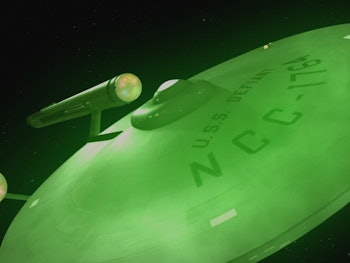
The latest episode of Star Trek: Discovery casually makes a deep dive into hardcore Trek lore with a bunch of original series references, but it also drops a super deep-cut plotline from a 2005 episode of the prequel series Star Trek: Enterprise. The USS Defiant referenced in this new Discovery episode is not the ship from Deep Space Nine , and for the uninitiated, it does have a slightly confusing history in the Trek canon. So much so, even the showrunners of Discovery knew bringing this old ship into the fold would be trickier than Captain Lorca’s Scotty impersonation.
Spoilers ahead for Star Trek: Discovery episode 10, “Despite Yourself.” And oddly, spoilers for Back to the Future II as well.
In “Despite Yourself,” the crew figures out that in order to get back to their own universe, they might need some other intel on another Starfleet ship that crossed over into this dimension: the USS Defiant , registry NCC-1764. As Burnham explains: “It’s unclear but data suggests that in the future, Defiant will encounter a phenomenon that will bring it into this alternative universe’s past.” And as Tilly says in the new episode, “What the heck! Hold your horses!” That’s right, the Defiant crossing over to the Mirror Universe is in the future for the characters of Discovery , but the point when it pops out in the Mirror Universe is like a century in the past . And the original series episode in which it first crossed over, wasn’t even about the Mirror Universe.
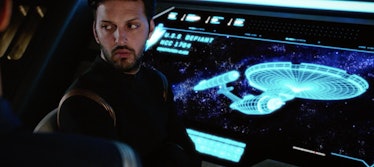
The Defiant first appeared in Trek canon in a 1968 third season episode of the original series called “The Tholian Web,” which, as you might guess, involves the Enterprise being trapped in a web created by some guys called the Tholians. To be clear, chronologically, everything in the original series (except for “The Cage”) hasn’t happened yet for the people on Discovery.
So, in “The Tholian Web,” Defiant was a sister ship of the old Enterprise , meaning it pretty much looked exactly the same when Kirk and Spock beamed over to it. Nothing about this episode was about the Mirror Universe, the only original series episode that was about the Mirror Universe was “Mirror, Mirror” in the second season. But, through the course of “The Tholian Web,” the Defiant got sucked into another dimension, though we never knew where it went.
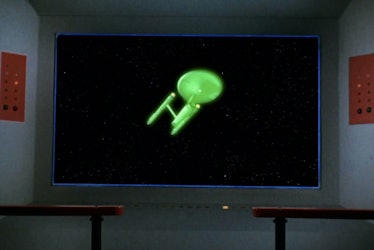
The first appearance of the Defiant in "The Tholian Web." When it disappeared, it got green.
Fast-forward (and backward) to 2005. The prequel series Enterprise is in its fourth and final season and does a two-part episode called “In a Mirror, Darkly,” which takes place entirely in the Mirror Universe. Like the rest of this series, “In a Mirror, Darkly” occurs in the 22nd century, about 100 years before the original series. And it’s here, where all the stuff in Burnham’s explanation from the new Discovery episode happened. It turns out that when the Defiant phased out of the regular dimension in “The Tholian Web,” it not only ended up in another dimension but it time-traveled into the past, too. Analogously, this is kind of like what happened to Marty and Doc in Back to the Future II when they leave 2015 and end up in an evil version of 1985. Only, unlike Back to the Future II , both the time travel and the dimension switching were a total accident. Basically, as temporal anomalies go, the one that got the Defiant in “The Tholian Web,” was a double-whammy.
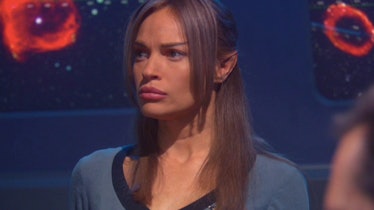
In "In a Mirror, Darkly," T'Pol from the Mirror Universe borrowed some retro Star Trek clothes from the Prime Universe USS Defiant. This is like wearing vintage clothes in the real world with zero knowledge of history. So, exactly like at least half the people you know who wear vintage clothes. The big difference here is these retro clothes were technically in T'Pol's alternate future. Does anybody need a nap?
“My brain still melts when I think about the Defiant . And that temporal anomaly,” co-showrunner Aaron Harberts tells Inverse. “We have always come at this from the standpoint of let’s tell the best story. What’s the best part about the Mirror Universe? And then go to the huge Trek fans that are on our staff who have watched all of Enterprise and say, ‘Okay. Now tell us about the Defiant .’ And then we kind of get nervous and then we kind of figure out a way to address it so that the fans who have done the deepest dive on the show know that we know that the Defiant existed. But the key is to really make sure that anybody could enjoy this trip over to the parallel universe.”
Most Trekkies will probably agree, that if you’ve seen this episode, having Burnham just quickly explain this in one sentence was probably the best way to go. Knowing all the details of where the Defiant comes from isn’t super important to the plot or the themes of the episode, but for completists, it’s certainly cool.
For those who still might be wondering about the other Star Trek ship called Defiant , here’s the quick explanation. It just has the same name. That’s it. But —and this might blow someone’s mind — there was another version of this other Defiant in the Mirror Universe, too. And, to make matters weirder, it had to be built by people from the Prime Universe. In “Shattered Mirror,” Terran rebels kidnapped Captain Sisko to make him help them complete their rip-off version of his Defiant.
Still, let’s not get worried about that right now. All of that is way in the future of stuff that is happening on Star Trek: Discovery right now, so there’s no need for Trekkies to call up Gretchen J. Berg and Aaron Harberts and tell them about the other Mirror Universe Defiant. Are we clear?
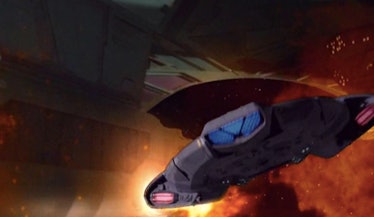
Another Defiant, in the Mirror Universe, like 100 years after stuff happening on 'Discovery' in a "Deep Space Nine' episode called "Shattered Mirror" that aired in 1996. But don't worry, this has nothing to do with 'Discovery.'
“I think after the wrap is when I had my panic attacks. When I realized, oh my gosh. Like, oh my gosh,” Berg said in reference to the Defiant time-travel and alternate universe shenanigans. “But we have to make sure that we tend to this in the way that it needs to be tended to but it sure takes a village.”
New episodes of Star Trek: Discovery air on Sundays at 8:30 p.m. Eastern on CBS All Access.
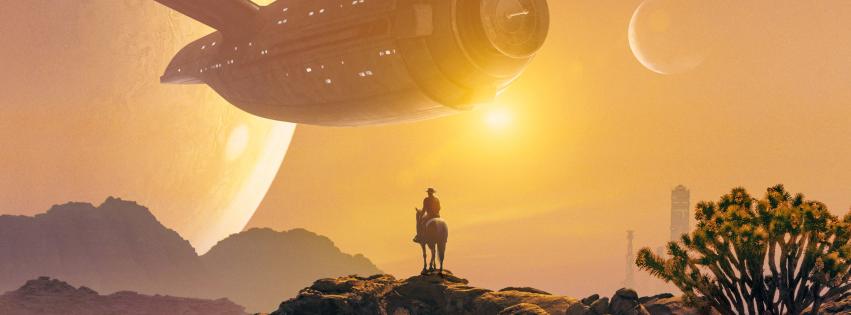
- Star Trek: Strange New Worlds
- Star Trek: Strange New Worlds News
- Star Trek: Strange New Worlds Reviews
- Star Trek: Strange New Worlds Episode Guide
Star Trek: Strange New Worlds Quotes
- Star Trek: Strange New Worlds Cast
- Star Trek: Strange New Worlds Pictures
Follow Star Trek: Strange New Worlds
- Is Strange New Worlds the Most Innovative Star Trek Series Since the Original?

As Star Trek is almost 60 years old, the latest series from this iconic Sci-Fi series may be the most groundbreaking since the original series.
The refreshing and entertaining storyline will please both newer fans of Star Trek and even the fans of the original Star Trek series that aired back in 1966.
The first season of Star Trek Strange New Worlds first premiered on the fifth of May 2022. It is actually a sequel to the slightly controversial Discovery series that didn't follow some of the known or established lore in the Star Trek universe.
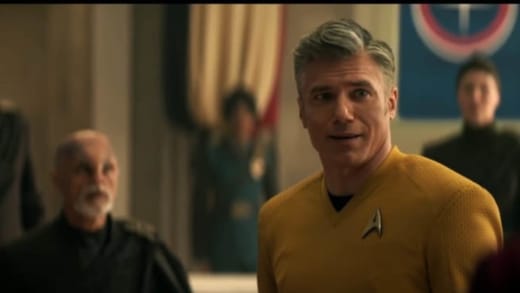
How Does Strange New Worlds Fit Into The Star Trek Universe
The original Star Trek series takes place in 2265, while the Strange New Worlds series starts in 2259. This means the iconic Captain Kirk is not the captain of the USS Enterprise (NCC-1701), which means the current captain will be Captain Christopher Pike .
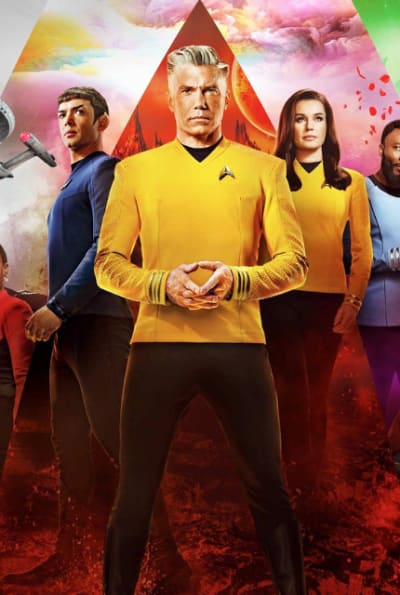
This may be a bit of a change for some Star Trek fans, but it's a good change.
Star Trek's iconic characters from the original series, such as Spock, Scotty, and Nyota Uhura, are also in the Strange New World series.
Some minor characters from the original show also appear throughout the new series, making Strange New Worlds feel like the show was meant to be.
Why is Strange New Worlds The Most Innovative Star Trek Show In Many Years
As the Star Trek: Strange New Worlds series shows us the adventures of Captain Christopher Pike and the crew at the start of USS Enterprise, it will immediately be compared to the original series.
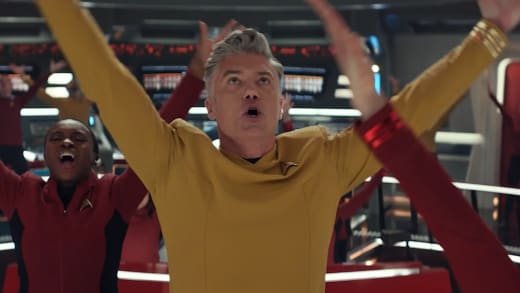
The cast of the new Star Trek show has a compelling story arc, which can make fans of the show feel attached and almost there with them during the crew's many adventures.
The new show takes many elements of the original show, such as the optimism and fun that the crew seems to lavish on.
This does not mean the Strange New Worlds series doesn't have any heart-wrenching moments. The show does have some heavy hitters, as any Star Trek fan knows the fate of Captain Christopher Pike.
Spoiler warning for new Star Trek fans who haven't watched the original series or finished Star Trek: Strange New Worlds Season 1 :
Captain Christopher Pike will die.
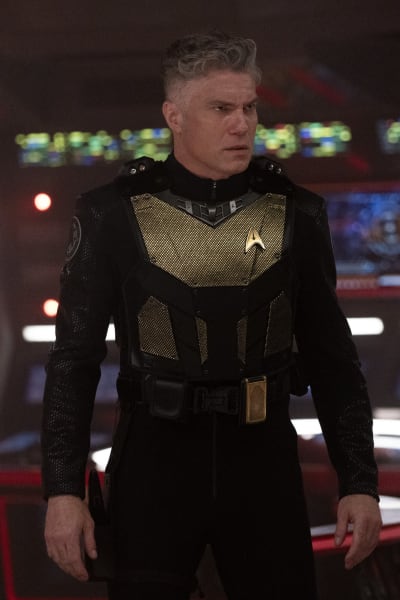
Captain Christopher Pike's death happened in 2266, seven years after the Strange New Worlds series started and two years after the original series.
Christopher Pike dies during an accident while trying to save a handful of trainees on a Class J Starship.
Strange New Worlds doesn't shy away from the fact that Captain Christopher Pike will die; during the show, he learns that he will die and that he has to learn to face his future.
Anson Mount , who plays Christopher Pike in the Strange New Worlds series, gives us one of the best Star Trek captains who has even been in the series.
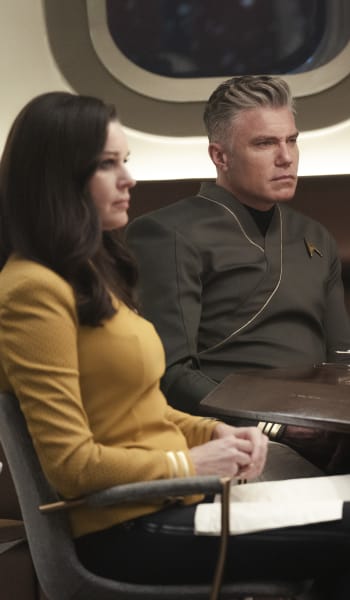
Anson Mount conveys the essence of how a Star Trek captain should act and treat his crew during any situation, even during a stressful situation.
This doesn't mean this captain doesn't break the rules; he just bends them when there is a need to do so.
Another great reason many Star Trek fans hold Strange New Worlds in such high regard is that it is family-friendly.
This alone is why the show is so popular, as families who grew up watching Star Trek can now spread the joy of Star Trek to their children without worrying about any taboo subjects or vulgar words popping up in the episode.
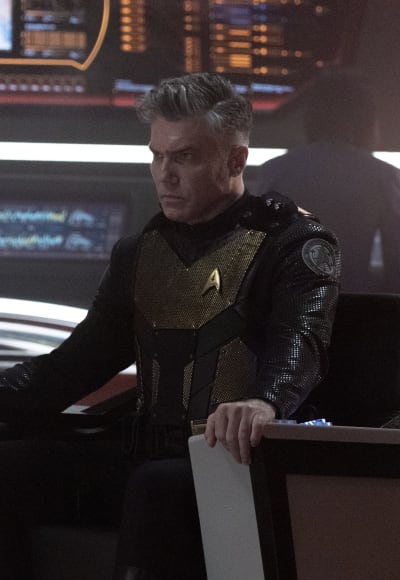
Why Does Star Trek: Strange New Worlds Look So Good?
Strange New Worlds does a great job of using the older elements and designs of the original series while still finding new ways to improve the show's look and feel.
For example, during the Star Trek: Discovery series, the USS Enterprise does make an appearance in the show.
However, the design elements did not match how the starship was supposed to look during the original series.
The latest Star Trek series did a great slight remodel of the starship hull to bring it closer to the original designs while still giving the design a modern feel.
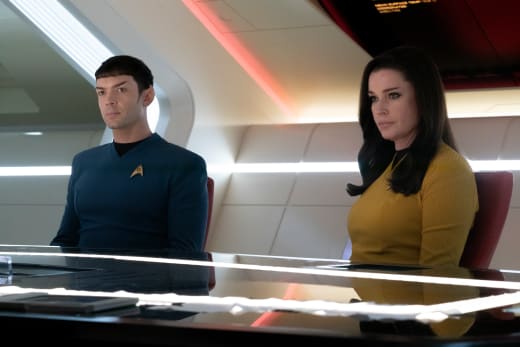
Some fans of the original series may think that the "new" USS Enterprise may look too modern and have lost the charm of the '60s version; this can be seen with the bridge of the Enterprise.
The bridge of a starship in Star Trek is the most important room on all Star Trek shows; this means they are iconic, and many fans know exactly how they look.
The Strange New Worlds creators revamped the bridge with its own elegant and unique design, but it still has many elements of the original set.
The Strange New Worlds series also relies heavily on props and filming sets that help the actors easily immerse themselves in their roles.
This allows the acting and chemistry between the actors to flow naturally.
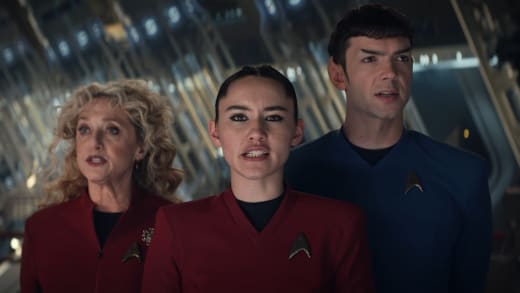
How Will the Show Progress?
As the Strange New Worlds series is a prequel to the original series, there is only so much time before they reach the original series starting date.
But don't worry because this doesn't mean that the show will not have any compelling stories or familiar faces for fans to enjoy.
As the series continues on Paramount+ , we'll surely see some exciting and unique storylines.
What do you think about the two shows?
Is Strange New Worlds truly more innovative than the Original?
Jason Collins is a staff writer for TV Fanatic. You can follow him on X .
Pike: Send someone else. You don't want me in command of that ship. April: You're getting us confused. You don't want you in command. Permalink: You're getting us confused. You don't want you in command. Added: May 04, 2022
No matter how many stars there are in the sky. No matter how many galaxies swirl beyond our own. No matter the mathematical probabilities or the number of times we say, 'We are not alone in the universe,' our first visit from the stars is always the province of children's stories and science fiction. First contact with aliens always lives squarely in the impossible. First contact is just a dream until one day, it isn't. Una Permalink: No matter how many stars there are in the sky. No matter how many galaxies swirl beyond our... Added: May 04, 2022

Star Trek: Strange New Worlds Photos

- February 2024
- January 2024
- 2023 Archives
- 2022 Archives
- 2021 Archives
- 2020 Archives
- 2019 Archives
- 2018 Archives
- 2017 Archives
- 2016 Archives
- 2015 Archives
- 2014 Archives
© 2024 TV Fanatic | About Us | Copyright Inquiry | Privacy Policy | Contact Us
© 2024 TV Fanatic

New Star Trek Prequel Movie Is Officially Official, Andor And Black Mirror Director Confirmed
C aptain's Log: Stardate 2024. It's been eight years since the USS Enterprise's last voyage on the big screen, with the franchise having since returned to its roots on television. During that period, the property has proliferated thanks to an influx of streaming series that's included everything from a "Next Generation" reunion to a raunchy cartoon and a wonderfully silly musical episode . But through it all, the question has lingered: when will Trekkies get to undertake another mission painted on the largest canvas available?
It's not been for lack of effort on Paramount's part. Ever since the commercial disappointment of 2016's "Star Trek Beyond" brought the escapades of the Kelvin Universe film series to a halt, the studio has cycled through one filmmaker after another in its quest to get "Star Trek" up and running in theaters once more. Most recently, it turned to "Black Mirror" director Toby Haynes to helm a new chapter based on a script by "Abraham Lincoln: Vampire Hunter" and "The LEGO Batman Movie" scribe Seth Grahame-Smith. At the same time, Paramount has continued to try and mount a fourth and final chapter in the Kelvin Timeline story that began with J.J. Abrams' "Star Trek" in 2009, having only barely recruited Steve Yockey ("The Flight Attendant") to work his magic on the screenplay.
Thankfully, we finally got an official update today during Paramount's CinemaCon presentation in Las Vegas (which /Film's Ryan Scott was there to witness with his own two eyes). The studio confirmed that Haynes' film will usher in the franchise's long-awaited return to theaters while, apparently, also functioning as a prequel to the previous Kelvin Universe movies. Production will begin later this year.
Read more: 12 Reasons Why The Original Series Is The Best Star Trek Show
Star Trek Will Boldly Go Before It's Never Gone Before
Literally winding back the clock for a mission is common practice in "Star Trek," so much so that the property even has a strict set of rules covering all the do's and don'ts of time travel (lest anyone step on a butterfly and wipe James Kirk out of existence). Prequels, on the other hand, only really came into vogue in the 2000s with the one-two punch of "Star Trek: Enterprise" and Abrams' film, the latter of which also introduced the alternate timeline known as the Kelvin Universe. Now, much as its big screen reboot 15 years ago served to reinvigorate the franchise while also appealing to a new generation of Trekkies, it's possible Paramount's goal here is for Haynes' prequel to revive the Kelvin series before bringing the main cast back while at the same time offering a jumping-on point for those who're new(ish) to the whole trekking across space thing.
Haynes' movie itself has previously been described as an "origin story" for "Star Trek" at large , which certainly supports the idea of it functioning as a soft reset without actually wiping out any earlier continuity (just like Abrams' movie). The director, for his part, has already demonstrated an appreciation for the property with his acclaimed "Black Mirror" episode "USS Callister" -- a darkly satirical take on "Star Trek" tropes and toxic fandom -- while his work on the "Star Wars" series "Andor" proves he's more than up for the task of taking a beloved sci-fi property and subverting it in fresh and exhilarating ways. With a little luck, these past eight years will prove to be more than worth the wait.
Keep it tuned to /Film for further updates on anything and everything "Star Trek."
Read the original article on SlashFilm


- April 16, 2024 | See The Organians Return In Preview Of ‘Star Trek’ #19
- April 15, 2024 | Actor Talks “Authentic” Scotty On ‘Star Trek: Strange New Worlds’; Season 3 Production Passes Milestone
- April 15, 2024 | Review: ‘Star Trek: Lower Decks’ Season 4 On Blu-ray Brings It All Together
- April 15, 2024 | Preview ‘Star Trek: Discovery’ Episode 504 With New Images And Clip From “Face The Strange”
- April 12, 2024 | Interview: Wilson Cruz On How “Jinaal” Sets Up The Rest Of The Season For Culber On ‘Star Trek: Discovery’
Review: ‘Star Trek: Lower Decks’ Season 4 On Blu-ray Brings It All Together
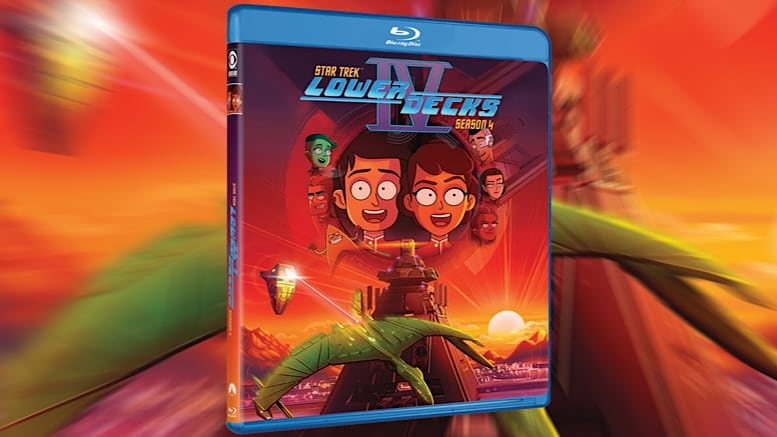
| April 15, 2024 | By: Matt Wright 17 comments so far
Before the fifth ( and now final ) season arrives this fall, the fourth season of the adult animated Star Trek comedy arrives on physical media this week in the USA.
Star Trek: Lower Decks – Season Four
Creator Mike McMahan and his team have consistently impressed with each successive season of Lower Decks . This fourth season could be considered the unifying theory of everything Lower Decks . Season 4 ties junior officers from all over the quadrant, some of which we’ve met before, into the namesake and inspiration of the show ( Next Generation’s “Lower Decks”), and that episodes’s roots which go even further back to TNG’s “The First Duty.” Of course the series continues to have meta fun with fan questions, such as whether Tom Paris and Nick Locarno are the same person — they’re not. The latest season also expands on Trek canon, such as exploring Orion culture thanks to Tendi (and her alternate life as Mistress of the Winter Constellations), which is most welcome. Despite being one of the more well known (and infamous) species in Trek we still know so little about the Orion way of life.
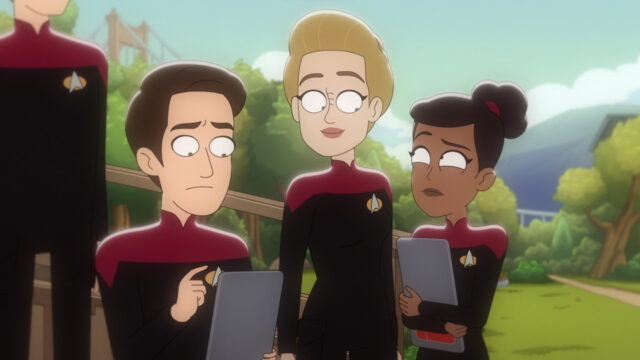
A young wide-eyed Mariner tries to impress upperclassman Sito Jaxa
While there’s a lot of fun and often irreverent comedy, something that continues to stand out is the general optimism of the show and the caring that nearly every character demonstrates. There’s been clear character growth from season to season, and this season shows us Mariner getting to the roots of her disdain for rank (and thus promotion) and procedure.
Personal favorites this season include: “I Have No Bones Yet I Must Flee” (it scores points for the title alone, and of course the episode gives us the terrifyingly cute Moopsy), “Parth Ferengi’s Heart Place,” “Caves,” and the season finale “Old Friends, New Planets.”
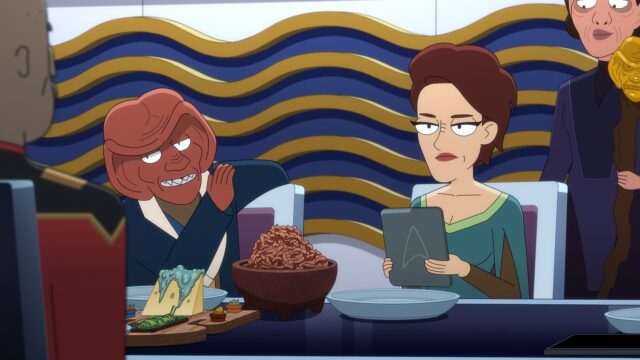
Rom and Leeta play Admiral Vassery for a sucker
The Blu-ray Set
The episodes and special features are on two Blu-ray discs. As has become standard for these CBS/Paramount+ releases, each disc has the names of the episodes it contains printed on them as well as a full listing for the set on the inside front/back of the case.
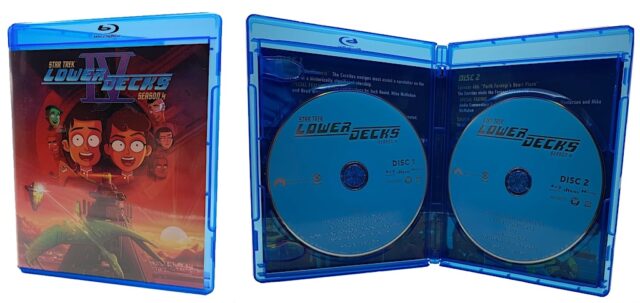
Video Quality
Lower Decks is a modern high-definition-era cartoon; as such, everything looks sharp, the lines are crisp, and the primary colors of the uniforms pop. The cartoon looked great streaming and looks a bit better here on disc.
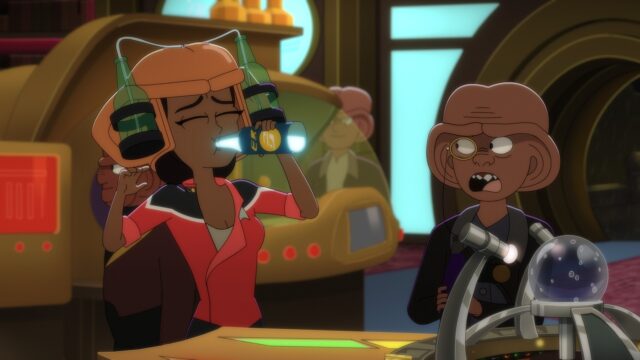
Mariner (overdoing it) with Quimp on Ferenginar
Audio Quality
As we’ve come to expect, the episodes have losslessly compressed DTS-HD MA 5.1 channel soundtracks. While this is standard for a TV show release, the sound design is excellent as always, we’d expect nothing less from the Emmy nominated team.
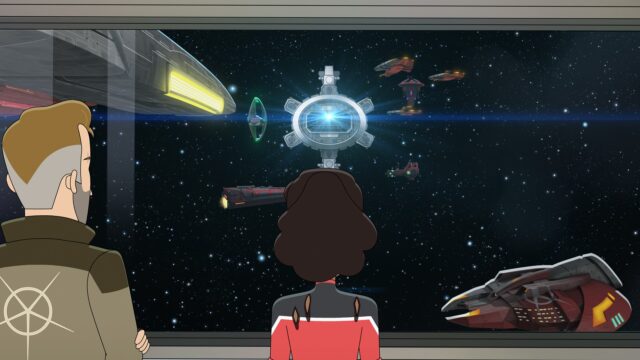
Mariner with a disgruntled Nick Locarno look out at the Nova Fleet
Special Features
The season set comes with a couple of new documentaries, and a generous five audio commentaries — which means half the episodes have a commentary, pretty cool.
Featurettes
Lower Decktionary: Setting Up Season 4 (9 minutes) – Showrunner Mike McMahan talks about the first episode of season 4, set on the USS Voyager. Including where we left off with the crew at the end of season 3, and the goals for the season. We hear from Eugene Cordero about how he couldn’t believe there was a “cheese episode” of Voyager , also Tawny Newsome, Noël Wells, and Jack Quaid chime in about getting promotions at the beginning of the season, rather than the end. Mike McMahan also weighs in on the Tuvix ethical dilemma.
Old Friends (28 mins) – Mike McMahan starts off saying how he much he loved “ wej Duj ” from season two, and that he realized this season’s cold opens could be vignettes showing various alien ships and their disaffected lower deckers. He then takes the audience through his process to develop Mariner’s backstory, tying it into the show’s inspiration: TNG “Lower Decks”, and how they handled incorporating the legacy characters, including tracking down Shannon Fill (who had retired from acting) to come back to do the Starfleet Academy flashbacks. Robert Duncan McNeill, Shannon Fill, and Wil Wheaton meet up (virtually) for the first time in years to discuss the filming and the legacy of TNG: “The First Duty.”
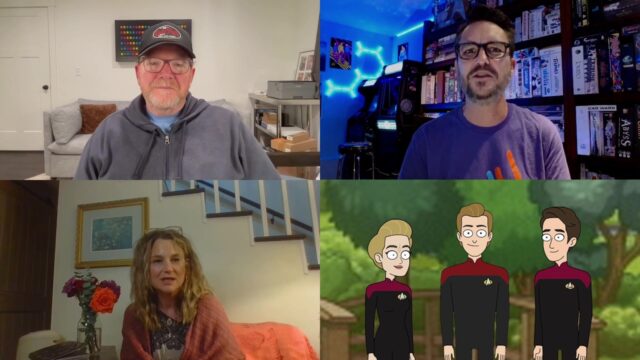
Robert Duncan McNeill, Wil Wheaton, and Shannon Fill discuss “The First Duty”
Episode commentaries
There are audio commentaries on five episodes. As one might imagine, with the amount of camaraderie seen at conventions and in previous documentaries, and the fact that a lot of these folks are voice actors and comedians, these commentaries are a good listen.
- “Twovix” with Jack Quaid, Mike McMahan, and Brad Winters
- “Something Borrowed, Something Green” with Tawny Newsome, Noël Wells, and Gabrielle Ruiz
- “Parth Ferengi’s Heart Place” with Noël Wells, Eugene Cordero, Chase Masterson, and Mike McMahan
- “The Inner Fight” with Dawnn Lewis, Tawny Newsome, and Mike McMahan
- “Old Friends, New Planets” with Robert Duncan McNeill, and Mike McMahan
Final Thoughts
For most people, this Blu-ray is the highest quality way to watch Lower Decks , so for those who care about getting the best audio-video experience, this is the set for them. It’s also the only way to get the episode commentaries. Recommended for collectors as well as anyone who wants an offline copy of the show; this includes people who cannot or do not want to stream the show and folks who have concerns about the fleeting rights to streaming media.
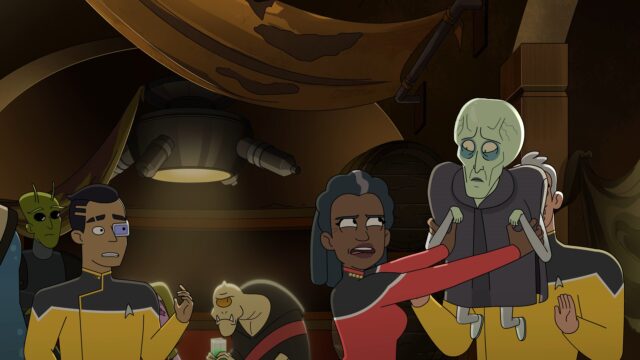
Captain Freeman mistakes a familiar looking alien for a puppet
Available Tuesday
Lower Decks Season 4 will be available on Blu-ray and DVD in the USA and Canada on Tuesday, April 16. You can order it from Amazon by clicking on your preferred format below.
Season 4 is also available at Amazon on digital which also includes special features.
DISCLAIMER: When we link to products to buy on Amazon in our articles, these are customized affiliate links that support TrekMovie by earning a small commission when you purchase through them.
Keep up with all the home video and streaming news, reviews, and analysis at TrekMovie.com.
Related Articles
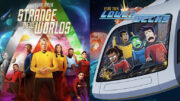
Lower Decks , Strange New Worlds
‘Star Trek: Strange New Worlds’ Renewed For Season 4; ‘Lower Decks’ To End With Season 5

All Access Star Trek Podcast , Discovery , Lower Decks , Star Trek: Picard , Star Trek: Prodigy , Starfleet Academy , Strange New Worlds
Podcast: All Access Goes To SXSW For The ‘Star Trek: Discovery’ Season 5 Premiere
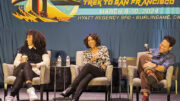
Conventions/Events/Attractions , Lower Decks
‘Star Trek: Lower Decks’ Cast Pitches Musical Episode And Another ‘Strange New Worlds’ Crossover
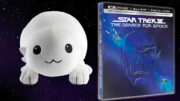
Collectibles , DVD/Blu-ray/Streaming , Feature Films (TMP-NEM) , Lower Decks
Star Trek Merch: ‘Lower Decks’ Moopsy Plush And ‘Search For Spock’ Anniversary Steelbook Available For Pre-Order
McMahan, I know you worship Star Trek, but just commission the designers to come up with original posters please. You don’t have to copy *EVERYTHING* from classic Trek.
When I read this I get the impression you don’t really get Lower Decks.
Sure, but that’s kind of the entire gimmick with these seasonal posters. It’s… it’s the whole point.
Much like Picard Season 3, strip away the nostalgia, cameos and references… is there anything else there? With Lower Decks there is, but it’s a struggle to find it sometimes, and rip-off posters don’t help.
Of course there is, I think perhaps the animation and/or humor distracted you too much from the pure Trekkiness at the heart of every story.
Copying everything… like every single post I’ve read of yours lately?
That’s the *joke*. When they announced the cancellation, I was immediately sad that they wouldn’t be able to do the first six movies at least.
Yeah, purchasing something digitally isn’t actually “ownership,” and we’ve all seen that streaming isn’t the magical vault where movies and TV will live forever.
If you want to make sure you have access to Lower Decks (or any film or show for that matter), physical media is the way to go.
I wholeheartedly second this comment….
My copy should arrive tomorrow. Star Trek is one of those franchises I will always have on physical media. I mean, we’ve been told Paramount Plus isn’t planning on removing Lower Decks from the service like they did Prodigy , but who the heck knows how that will look a year from now?
Especially if Paramount’s financial issues get even bigger and they need to make more drastic cuts.
Canceling a relatively inexpensive (by comparison) and generally well-liked show like Lower Decks…and make no mistake, this was a cancellation…shows to me that Paramount is already in serious cost-cutting mode.
I’ll be honest, I’m not entirely confident SNW will make it to S4 either…we’ve seen greenlights reversed before.
EXACTLY!!!!
I’m definitely ordering it. Lower Decks looks great on bluray. I’m watching S3 on bluray and the animation is stunning. I hate that this is the penultimate season. These writers can pack a lot into 22 minutes and it’s delightful. I can’t wait to hear the commentaries.
Definitely picking this up!
Pre-ordered and should arrive today or tomorrow. I LOVE how each DVD slipcase season copies the classic Star Trek movie poster — LOVING the copy of the Voyage Home poster. Been binge-watching season 2 and three and loving the series. So much optimism, so meta and still so much FUN.
Screen Rant
Star trek: discovery just made a mirror universe theory more likely.
A TOS reference in Star Trek: Discovery's season 5 premiere suggests the USS Defiant may return from the Mirror Universe, confirming a fan theory.
WARNING: This article contains SPOILERS for Star Trek: Discovery season 5, episode 1, "Red Directive"
- The return to the Mirror Universe in Star Trek: Discovery season 5 is teased by a Terran Empire logo in the trailer.
- Captain Saru mentions the Tholian Republic as a threat, setting up for a potential return to the Mirror Universe.
- The USS Defiant from Star Trek: The Original Series could play a key role in a bridge to the Mirror Universe in season 5.
One line from Star Trek: Discovery season 5, episode 1, "Red Directive" makes a return to the Mirror Universe more likely, confirming a fan theory. Discovery last paid a visit to the Mirror Universe in the season 3 two-parter "Terra Firma", in which the Guardian of Forever sent Philippa Georgiou (Michelle Yeoh) back to her last day as Terran Emperor. The return to the Mirror Universe was part of an elaborate test by the Guardian, now assuming the form of Carl (Paul Guilfoyle) , to prove the positive impact of Georgiou's experiences in the prime Star Trek timeline .
Now it seems that Star Trek: Discovery could be making a final return to the Mirror Universe in season 5. The final trailer for Discovery season 5 appeared to show L'ak (Elias Toufexis) standing in front of what appeared to be the symbol of the Terran Empire . Star Trek: Deep Space Nine revealed that the Terran Empire had fallen in the 24th century, but it's certainly possible that it could have risen again in the 800 years between DS9 and Discovery . How the USS Discovery's treasure hunt would lead to a return to the Mirror Universe is unclear, but there's a small hint in season 5's premiere.
Star Trek: Discovery Season 5, Episode 1 Ending & TNG Treasure Explained
Discovery’s season 5 premiere made a mirror universe theory more likely.
The Star Trek: Discovery season 5 trailer teased a tense gunfight aboard what appeared to be a 23rd century Constitution-class starship. This has led fans to speculate that it could be the USS Defiant from Star Trek: The Original Series , the starship that phased in and out of reality in "The Tholian Web". That theory gets a further boost in Discovery season 5, episode 1, as Captain Saru (Doug Jones) outlines possible threats to the Federation in the 32nd century .
Saru reveals that the Breen Imperium and the Tholian Republic are potential threats to the Federation in Star Trek: Discovery season 5 . It's even possible that either of these classic Star Trek aliens could seek the Progenitors' technology to gain an advantage over the Federation. Saru's mention of the Tholians also gives Discovery a pathway back to the Mirror Universe later in season 5, perhaps affording the chance to settle some unfinished business.
Who Are Star Trek: TOS’ Tholians And How Do They Connect To The Mirror Universe?
In Star Trek: The Original Series , season 3, episode 9, "The Tholian Web", the USS Enterprise encounters the stricken USS Defiant. The entire crew killed each other, driven insane by the effects of a spatial interphase caused by the non-humanoid Tholians. Star Trek: Enterprise revealed that it was the Tholians from the Mirror Universe that had actually dragged the USS Defiant out of their own time and reality, dragging it backwards into the 22nd century. Captain Jonathan Archer (Scott Bakula) of the ISS Enterprise NX-01 stole the Defiant, but the knowledge contained inside it led to a revolt aboard the ship .
The events of Star Trek: Enterprise 's Mirror Universe episodes later informed Star Trek: Discovery season 1's Mirror Universe arc . When the USS Discovery was dragged into the Mirror Universe by the machinations of Captain Gabriel Lorca, they used the information about the USS Defiant to return to their own reality. At the end of "The Tholian Web" - which takes place after Star Trek: Discovery - the USS Defiant is phased out of reality to parts unknown. Given that the Defiant had been dragged through both time and reality, it could have ended up in the 32nd century, providing Burnham with a bridge to the Mirror Universe.
Star Trek: Discovery streams Thursdays on Paramount+.
Star Trek: Discovery
*Availability in US
Not available
Star Trek: Discovery is an entry in the legendary Sci-Fi franchise, set ten years before the original Star Trek series events. The show centers around Commander Michael Burnham, assigned to the USS Discovery, where the crew attempts to prevent a Klingon war while traveling through the vast reaches of space.
Star Trek: The Original Series
Star Trek: The Original Series follows the exploits of the crew of the USS Enterprise. On a five-year mission to explore uncharted space, Captain James T. Kirk (William Shatner) must trust his crew - Spock (Leonard Nimoy), Dr. Leonard "Bones" McCoy (Forest DeKelley), Montgomery "Scotty" Scott (James Doohan), Uhura (Nichelle Nichols), Chekov (Walter Koenig) and Sulu (George Takei) - with his life. Facing previously undiscovered life forms and civilizations and representing humanity among the stars on behalf of Starfleet and the United Federation of Planets, the Enterprise regularly comes up against impossible odds and diplomatic dilemmas.
Star Trek: Enterprise
Star Trek: Enterprise acts as a prequel to Star Trek: The Original Series, detailing the voyages of the original crew of the Starship Enterprise in the 22nd century, a hundred years before Captain Kirk commanded the ship. Enterprise was the sixth series in the Star Trek franchise overall, and the final series before a twelve-year hiatus until the premiere of Star Trek: Discovery in 2017. The series stars Scott Bakula as Captain Jonathan Archer, with an ensemble cast that includes John Billingsley, Jolene Blalock, Dominic Keating, Anthony Montgomery, Linda Park, and Connor Trinneer.
A Star Trek Origin Movie Is Coming in 2025 From 'Andor' and 'Doctor Who' Director Toby Haynes
'Star Trek' (2009) director J.J. Abrams is attached to produce.
The Big Picture
- A new Star Trek prequel film, an "origin story", is in development, at Paramount.
- The Star Trek history before Kirk's missions on the Enterprise is largely unwritten, leaving room for creativity with the new film.
- Director Toby Haynes, known for Andor , is working on the film alongside writer Seth Grahame-Smith; a 2025 release window was announced at CinemaCon.
Star Trek may finally be coming back to the big screen. A prequel to the 2009 J.J. Abrams reboot of the franchise is in the works from director Toby Haynes . The news comes from Paramount's presentation at CinemaCon today, as reported by Collider's Steve Weintraub and Britta DeVore . With Haynes, who recently helmed six episodes of the acclaimed Star Wars series Andor , at the rudder, the film will be written by Seth Grahame-Smith .
So far, other details on the new film are scarce, but it will reportedly be an "origin story", taking place decades before the 2009 Star Trek film, which took place in 2255. That likely means that it will not feature the cast from the 2009 reboot, which has so far been difficult for Paramount to wrangle together for a fourth film, despite numerous attempts to do so . That doesn't necessarily mean that a fourth movie isn't happening: back in March, Paramount hired The Flight Attendant scribe Steve Yockey to pen a new script for the film. For their part, the cast is game as well, with Zoe Saldaña recently stating her willingness to return for a fourth mission on the USS Enterprise .
What Happened Decades Before Kirk's First Missions on the Enterprise?
The history of the Star Trek universe prior to the celebrated voyages of the Enterprise is largely unwritten. The first starship Enterprise 's adventures in the 22nd century were chronicled on the UPN prequel series Star Trek: Enterprise . That series ended with the founding of the United Federation of Planets in 2161, which leaves almost a century of mostly unexplored history between that and the history now being charted on Star Trek: Strange New Worlds (and the first two seasons of mothership show Star Trek: Discovery ).
At some point, the nascent Federation faces a devastating war against the Romulan Star Empire , while also engaged in a Cold War with the Klingons. The USS Enterprise will eventually be launched in the 23rd century, under the captaincy of Robert April, who has been briefly glimpsed on Star Trek: The Animated Series and Strange New Worlds , before being handed off to Christopher Pike . Apart from that, however, Haynes and Graeme-Smith have a near-blank canvas upon which to make their mark.
In addition to Andor , Haynes has also helmed episodes of Doctor Who , Sherlock , and Black Mirror ; his work on the latter series includes the episode " USS Callister ," a loving pastiche of Star Trek . Graeme-Smith wrote the novels Pride & Prejudice & Zombies and Abraham Lincoln, Vampire Hunter ; he worked on the story for the upcoming horror comedy sequel Beetlejuice Beetlejuice .
A new Star Trek prequel film is in development; no date has yet been set beyond a 2025 release window . Stay tuned to Collider for future updates.

IMAGES
VIDEO
COMMENTS
"Mirror, Mirror" is the fourth episode of the second season of the American science fiction television series Star Trek. Written by Jerome Bixby and directed by Marc Daniels, it was first broadcast on October 6, 1967.. The episode involves a transporter malfunction that swaps Captain Kirk and his companions with their evil counterparts from a parallel universe (later dubbed the "Mirror ...
Mirror, Mirror: Directed by Marc Daniels. With William Shatner, Leonard Nimoy, DeForest Kelley, BarBara Luna. A transporter accident places Captain Kirk's landing party in an alternate universe, where the Enterprise is in the service of a barbarically brutal empire.
The Mirror Universe is one of Star Trek's most intriguing and enduring concepts largely thanks to Gene Roddenberry's changes to the alternate reality in Star Trek: The Original Series.The Mirror Universe debuted in TOS's season 2 episode "Mirror Mirror", but the new book Star Trek: A Celebration, by Ben Robinson and Ian Spelling, explains how themes that Roddenberry and TOS' producing team ...
The mirror universe was a parallel universe widely recorded as first being visited by James T. Kirk and several officers from the USS Enterprise in 2267, though in reality already encountered by the USS Discovery around a decade earlier. This parallel universe coexisted with the prime universe in the same space, but on another dimensional plane. The mirror universe was so named because most ...
Star Trek's Mirror Universe has become a phenomenon since its introduction, and has been explored in multiple series across the franchise. Star Trek: The Original Series first introduced the Mirror Universe in "Mirror, Mirror," the only episode of the series to deal directly with the idea of a darker parallel universe.However, this idea was so interesting that it subsequently spread to other ...
A transporter malfunction sends Kirk, McCoy, Scotty, and Uhura into a parallel universe where the Federation is replaced by an evil Empire, Kirk is a despot, and Spock is a cunning henchman. A landing party from the USS Enterprise comprised of Captain Kirk, Scott, Dr. McCoy, and Uhura are on the Halkan homeworld, attempting to gain rights on behalf of the Federation to mine dilithium on their ...
The Mirror Universe is one of Star Trek's most intriguing concepts.The franchise has wisely used the Mirror Universe sparingly since it was introduced in Star Trek: The Original Series so that each appearance is an event. The alternate reality where nearly every beloved Star Trek character is the opposite of who they are in the Prime Universe has spanned TOS, Star Trek: Deep Space Nine, Star ...
The Mirror Universe is the setting of several narratives in the Star Trek science fiction franchise, a parallel universe existing alongside, but separate from, the fictional universe that is the main setting of Star Trek.It resembles the main Star Trek universe, but is populated by more violent and opportunistic doubles of its people. The Mirror Universe has been visited in one episode of Star ...
The Mirror Universe in the 2200s. The Early 2250s: The Coup Against Georgiou. In the episode "Vaulting Ambition," Emperor Georgiou revealed that Captain Gabriel Lorca led a coup against her ...
Star Trek's Mirror Universe Explained. In the iconic narration of Star Trek: The Original Series ( TOS ), Captain James T. Kirk vows to go "where no man has gone before." Numerous television ...
Deep Space Nine's Mirror Universe. Deep Space Nine did a deep dive into the Mirror Universe with five separate episodes across five different seasons: "Crossover" (Season 2), "Through the ...
Alternate universes and parallel timelines have been a subject of Star Trek stories from the word go, most recently showing up in th form of J.J. Abrams' movies' Kelvin Timeline.
Star Trek 's Mirror Universe is one of the franchise's most fascinating and unique elements. Beyond the rich storytelling opportunities, Trek 's forays into the darker alternate universe lets ...
"The Alternative Factor" is the twenty-seventh episode of the first season of the American science fiction television series Star Trek. Written by Don Ingalls and directed by Gerd Oswald, it first aired on March 30, 1967.. In the episode, the crew of the USS Enterprise encounters a "reality jumping" madman. It is the first Star Trek episode to deal with a parallel universe.
Star Trek has a love of time travel, but these alternate universe episodes allow for not just the ability to revisit characters that have been killed off, but also show how the actions of the ...
(These Are the Voyages: TOS Season One 1st ed., pp. 415-416) The Star Trek production team filed a grievance against Barrymore at the Screen Actors' Guild, which led to him being unable to obtain acting work for six months in 1967. (Inside Star Trek: The Real Story, pp. 201-202; These Are the Voyages: TOS Season One 1st ed., pp. 415-416, 420)
The Mirror Universe in Star Trek Television, Explained. By Mona Bassil. Published Dec 25, 2023. A fascinating and twisted reflection of the regular timeline of the Star Trek universe across four ...
Star Trek V: The Final Frontier also seems like a sequel to Star Trek II, Star Trek III, and Star Trek IV. But it is uncertain whether Star Trek V: The Final Frontier happens in the same alternate universe as Star Trek VI:The Undiscovered Country and thus in the same universe as all TNG, DS9, and VOY episodes.
The Alternative Factor: Directed by Gerd Oswald. With William Shatner, Leonard Nimoy, Robert Brown, DeForest Kelley. Existence itself comes under threat from a man's power-struggle with his alternate self, with the Enterprise's strained dilithium crystals presenting his key to a final solution.
Episode: Mirror, Mirror (1967) TV-PG | 50 min | Action, Adventure, Sci-Fi. 9. Rate. A transporter accident places Captain Kirk's landing party in an alternate universe, where the Enterprise is in the service of a barbarically brutal empire. Director: Marc Daniels | Stars: William Shatner, Leonard Nimoy, DeForest Kelley, BarBara Luna.
Alternate Universe 4 is a gen Star Trek: TOS Kirk-centric fanzine zine series with stories that take place in the shared universe known as Alternate Universe 4.. The series' premise centers around Kirk being court-martialed and eventually joining a secret organization of advanced aliens called Lightfleet (sometimes this is also called "Lightfleet Universe").
The latest episode of Star Trek: Discovery casually makes a deep dive into hardcore Trek lore with a bunch of original series references, but it also drops a super deep-cut plotline from a 2005 ...
Jason Collins at April 10, 2024 3:00 pm. As Star Trek is almost 60 years old, the latest series from this iconic Sci-Fi series may be the most groundbreaking since the original series. The ...
Prequels, on the other hand, only really came into vogue in the 2000s with the one-two punch of "Star Trek: Enterprise" and Abrams' film, the latter of which also introduced the alternate timeline ...
The Mirror Universe is an alternate reality that runs parallel to the main Star Trek timeline. Something of a dark mirror of the traditionally optimistic, progressive worldview of Star Trek, the Mirror Universe sees the benevolent Federation replaced by the evil Terran Empire, a violent, ruthless organization obsessed with conquest.
Video Quality. Lower Decks is a modern high-definition-era cartoon; as such, everything looks sharp, the lines are crisp, and the primary colors of the uniforms pop. The cartoon looked great ...
The Star Trek: Discovery season 5 trailer teased a tense gunfight aboard what appeared to be a 23rd century Constitution-class starship.This has led fans to speculate that it could be the USS Defiant from Star Trek: The Original Series, the starship that phased in and out of reality in "The Tholian Web".That theory gets a further boost in Discovery season 5, episode 1, as Captain Saru (Doug ...
Director Toby Haynes, known for Andor, is working on the film alongside writer Seth Grahame-Smith; a 2025 release window was announced at CinemaCon. Star Trek may finally be coming back to the big ...